Porter's Five Force Model of Vodafone
VerifiedAdded on 2021/02/18
|20
|6810
|28
AI Summary
Contribute Materials
Your contribution can guide someone’s learning journey. Share your
documents today.

Business Strategy
Secure Best Marks with AI Grader
Need help grading? Try our AI Grader for instant feedback on your assignments.
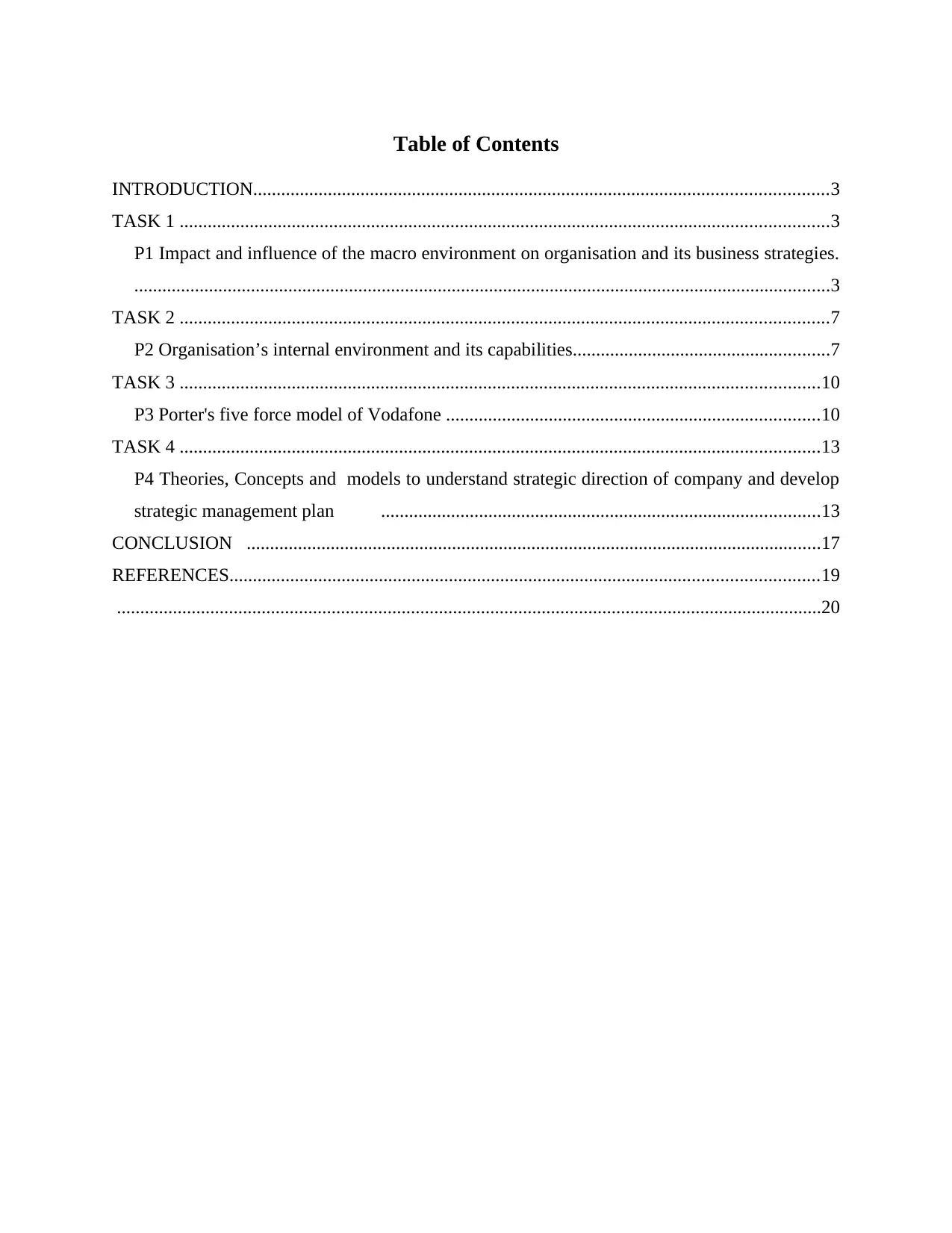
Table of Contents
INTRODUCTION...........................................................................................................................3
TASK 1 ...........................................................................................................................................3
P1 Impact and influence of the macro environment on organisation and its business strategies.
.....................................................................................................................................................3
TASK 2 ...........................................................................................................................................7
P2 Organisation’s internal environment and its capabilities.......................................................7
TASK 3 .........................................................................................................................................10
P3 Porter's five force model of Vodafone ................................................................................10
TASK 4 .........................................................................................................................................13
P4 Theories, Concepts and models to understand strategic direction of company and develop
strategic management plan ..............................................................................................13
CONCLUSION ...........................................................................................................................17
REFERENCES..............................................................................................................................19
.......................................................................................................................................................20
INTRODUCTION...........................................................................................................................3
TASK 1 ...........................................................................................................................................3
P1 Impact and influence of the macro environment on organisation and its business strategies.
.....................................................................................................................................................3
TASK 2 ...........................................................................................................................................7
P2 Organisation’s internal environment and its capabilities.......................................................7
TASK 3 .........................................................................................................................................10
P3 Porter's five force model of Vodafone ................................................................................10
TASK 4 .........................................................................................................................................13
P4 Theories, Concepts and models to understand strategic direction of company and develop
strategic management plan ..............................................................................................13
CONCLUSION ...........................................................................................................................17
REFERENCES..............................................................................................................................19
.......................................................................................................................................................20
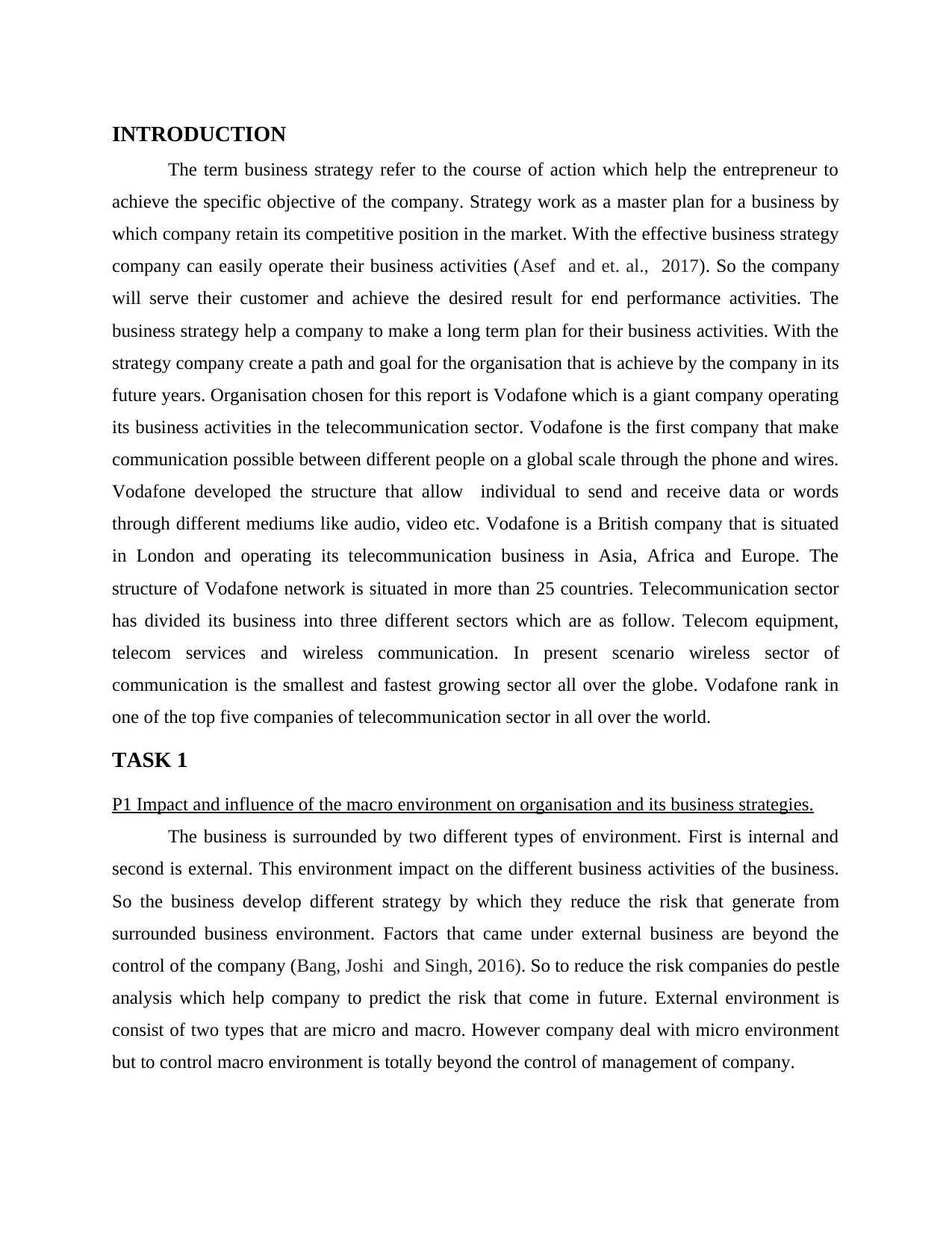
INTRODUCTION
The term business strategy refer to the course of action which help the entrepreneur to
achieve the specific objective of the company. Strategy work as a master plan for a business by
which company retain its competitive position in the market. With the effective business strategy
company can easily operate their business activities (Asef and et. al., 2017). So the company
will serve their customer and achieve the desired result for end performance activities. The
business strategy help a company to make a long term plan for their business activities. With the
strategy company create a path and goal for the organisation that is achieve by the company in its
future years. Organisation chosen for this report is Vodafone which is a giant company operating
its business activities in the telecommunication sector. Vodafone is the first company that make
communication possible between different people on a global scale through the phone and wires.
Vodafone developed the structure that allow individual to send and receive data or words
through different mediums like audio, video etc. Vodafone is a British company that is situated
in London and operating its telecommunication business in Asia, Africa and Europe. The
structure of Vodafone network is situated in more than 25 countries. Telecommunication sector
has divided its business into three different sectors which are as follow. Telecom equipment,
telecom services and wireless communication. In present scenario wireless sector of
communication is the smallest and fastest growing sector all over the globe. Vodafone rank in
one of the top five companies of telecommunication sector in all over the world.
TASK 1
P1 Impact and influence of the macro environment on organisation and its business strategies.
The business is surrounded by two different types of environment. First is internal and
second is external. This environment impact on the different business activities of the business.
So the business develop different strategy by which they reduce the risk that generate from
surrounded business environment. Factors that came under external business are beyond the
control of the company (Bang, Joshi and Singh, 2016). So to reduce the risk companies do pestle
analysis which help company to predict the risk that come in future. External environment is
consist of two types that are micro and macro. However company deal with micro environment
but to control macro environment is totally beyond the control of management of company.
The term business strategy refer to the course of action which help the entrepreneur to
achieve the specific objective of the company. Strategy work as a master plan for a business by
which company retain its competitive position in the market. With the effective business strategy
company can easily operate their business activities (Asef and et. al., 2017). So the company
will serve their customer and achieve the desired result for end performance activities. The
business strategy help a company to make a long term plan for their business activities. With the
strategy company create a path and goal for the organisation that is achieve by the company in its
future years. Organisation chosen for this report is Vodafone which is a giant company operating
its business activities in the telecommunication sector. Vodafone is the first company that make
communication possible between different people on a global scale through the phone and wires.
Vodafone developed the structure that allow individual to send and receive data or words
through different mediums like audio, video etc. Vodafone is a British company that is situated
in London and operating its telecommunication business in Asia, Africa and Europe. The
structure of Vodafone network is situated in more than 25 countries. Telecommunication sector
has divided its business into three different sectors which are as follow. Telecom equipment,
telecom services and wireless communication. In present scenario wireless sector of
communication is the smallest and fastest growing sector all over the globe. Vodafone rank in
one of the top five companies of telecommunication sector in all over the world.
TASK 1
P1 Impact and influence of the macro environment on organisation and its business strategies.
The business is surrounded by two different types of environment. First is internal and
second is external. This environment impact on the different business activities of the business.
So the business develop different strategy by which they reduce the risk that generate from
surrounded business environment. Factors that came under external business are beyond the
control of the company (Bang, Joshi and Singh, 2016). So to reduce the risk companies do pestle
analysis which help company to predict the risk that come in future. External environment is
consist of two types that are micro and macro. However company deal with micro environment
but to control macro environment is totally beyond the control of management of company.
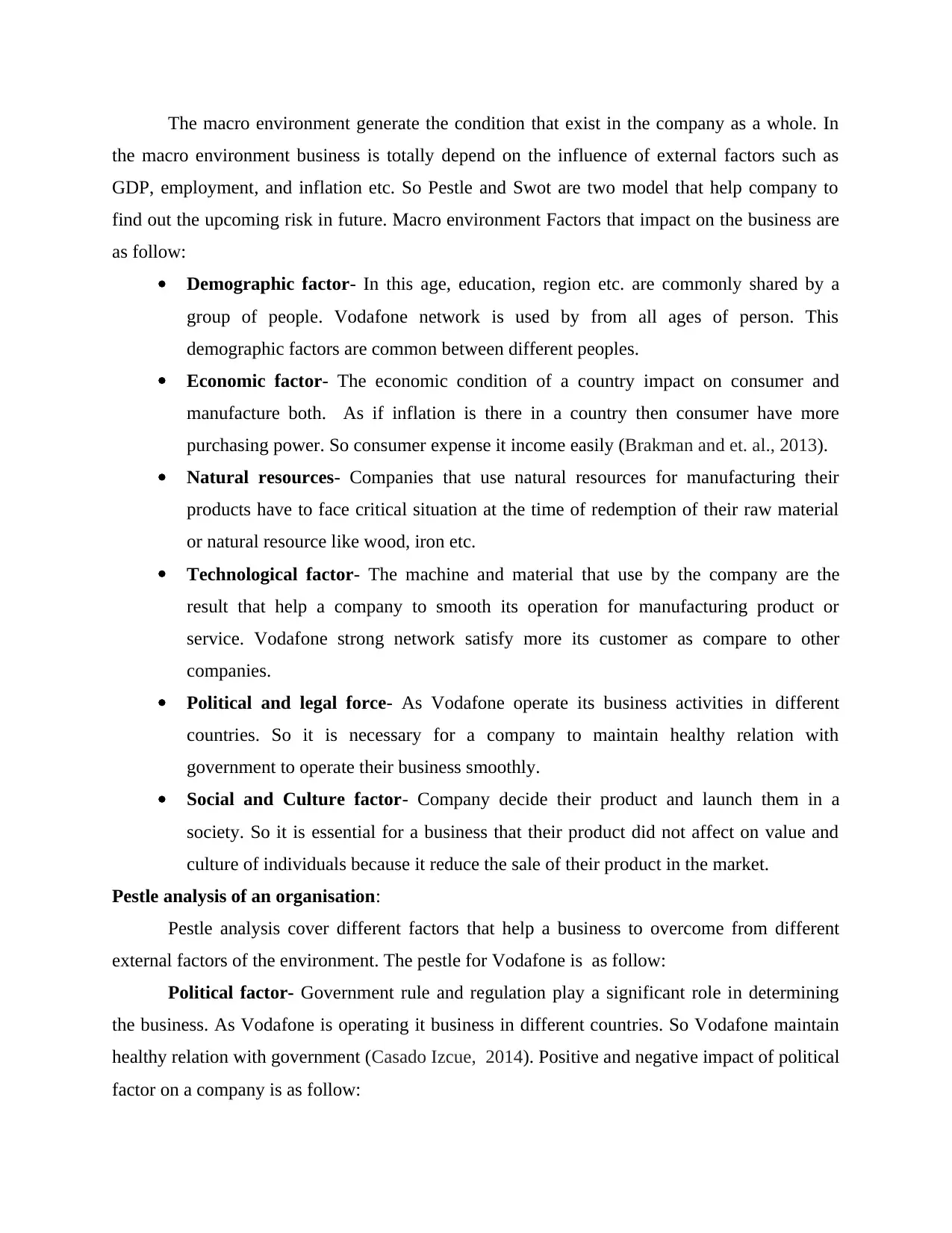
The macro environment generate the condition that exist in the company as a whole. In
the macro environment business is totally depend on the influence of external factors such as
GDP, employment, and inflation etc. So Pestle and Swot are two model that help company to
find out the upcoming risk in future. Macro environment Factors that impact on the business are
as follow:
Demographic factor- In this age, education, region etc. are commonly shared by a
group of people. Vodafone network is used by from all ages of person. This
demographic factors are common between different peoples.
Economic factor- The economic condition of a country impact on consumer and
manufacture both. As if inflation is there in a country then consumer have more
purchasing power. So consumer expense it income easily (Brakman and et. al., 2013).
Natural resources- Companies that use natural resources for manufacturing their
products have to face critical situation at the time of redemption of their raw material
or natural resource like wood, iron etc.
Technological factor- The machine and material that use by the company are the
result that help a company to smooth its operation for manufacturing product or
service. Vodafone strong network satisfy more its customer as compare to other
companies.
Political and legal force- As Vodafone operate its business activities in different
countries. So it is necessary for a company to maintain healthy relation with
government to operate their business smoothly.
Social and Culture factor- Company decide their product and launch them in a
society. So it is essential for a business that their product did not affect on value and
culture of individuals because it reduce the sale of their product in the market.
Pestle analysis of an organisation:
Pestle analysis cover different factors that help a business to overcome from different
external factors of the environment. The pestle for Vodafone is as follow:
Political factor- Government rule and regulation play a significant role in determining
the business. As Vodafone is operating it business in different countries. So Vodafone maintain
healthy relation with government (Casado Izcue, 2014). Positive and negative impact of political
factor on a company is as follow:
the macro environment business is totally depend on the influence of external factors such as
GDP, employment, and inflation etc. So Pestle and Swot are two model that help company to
find out the upcoming risk in future. Macro environment Factors that impact on the business are
as follow:
Demographic factor- In this age, education, region etc. are commonly shared by a
group of people. Vodafone network is used by from all ages of person. This
demographic factors are common between different peoples.
Economic factor- The economic condition of a country impact on consumer and
manufacture both. As if inflation is there in a country then consumer have more
purchasing power. So consumer expense it income easily (Brakman and et. al., 2013).
Natural resources- Companies that use natural resources for manufacturing their
products have to face critical situation at the time of redemption of their raw material
or natural resource like wood, iron etc.
Technological factor- The machine and material that use by the company are the
result that help a company to smooth its operation for manufacturing product or
service. Vodafone strong network satisfy more its customer as compare to other
companies.
Political and legal force- As Vodafone operate its business activities in different
countries. So it is necessary for a company to maintain healthy relation with
government to operate their business smoothly.
Social and Culture factor- Company decide their product and launch them in a
society. So it is essential for a business that their product did not affect on value and
culture of individuals because it reduce the sale of their product in the market.
Pestle analysis of an organisation:
Pestle analysis cover different factors that help a business to overcome from different
external factors of the environment. The pestle for Vodafone is as follow:
Political factor- Government rule and regulation play a significant role in determining
the business. As Vodafone is operating it business in different countries. So Vodafone maintain
healthy relation with government (Casado Izcue, 2014). Positive and negative impact of political
factor on a company is as follow:
Secure Best Marks with AI Grader
Need help grading? Try our AI Grader for instant feedback on your assignments.
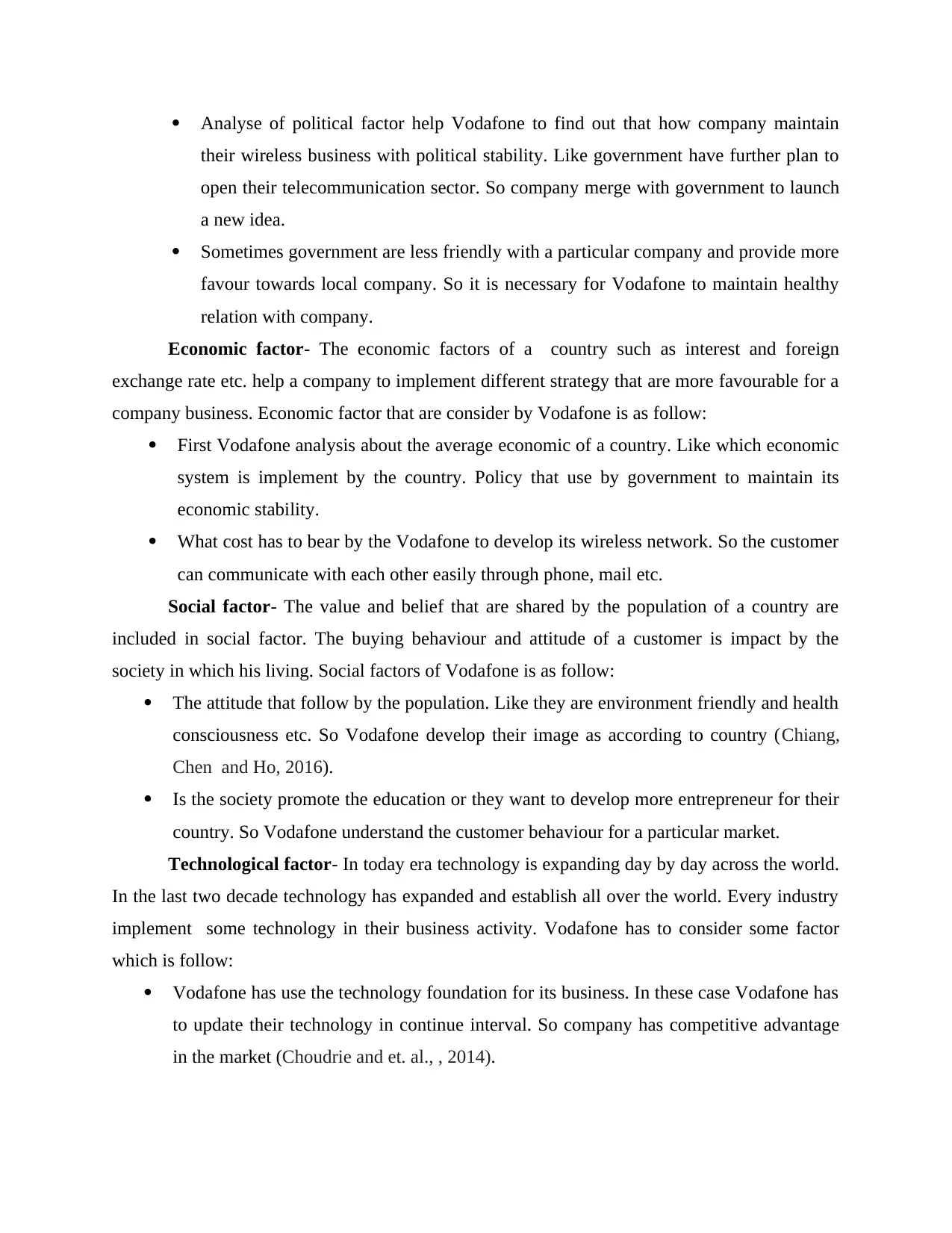
Analyse of political factor help Vodafone to find out that how company maintain
their wireless business with political stability. Like government have further plan to
open their telecommunication sector. So company merge with government to launch
a new idea.
Sometimes government are less friendly with a particular company and provide more
favour towards local company. So it is necessary for Vodafone to maintain healthy
relation with company.
Economic factor- The economic factors of a country such as interest and foreign
exchange rate etc. help a company to implement different strategy that are more favourable for a
company business. Economic factor that are consider by Vodafone is as follow:
First Vodafone analysis about the average economic of a country. Like which economic
system is implement by the country. Policy that use by government to maintain its
economic stability.
What cost has to bear by the Vodafone to develop its wireless network. So the customer
can communicate with each other easily through phone, mail etc.
Social factor- The value and belief that are shared by the population of a country are
included in social factor. The buying behaviour and attitude of a customer is impact by the
society in which his living. Social factors of Vodafone is as follow:
The attitude that follow by the population. Like they are environment friendly and health
consciousness etc. So Vodafone develop their image as according to country (Chiang,
Chen and Ho, 2016).
Is the society promote the education or they want to develop more entrepreneur for their
country. So Vodafone understand the customer behaviour for a particular market.
Technological factor- In today era technology is expanding day by day across the world.
In the last two decade technology has expanded and establish all over the world. Every industry
implement some technology in their business activity. Vodafone has to consider some factor
which is follow:
Vodafone has use the technology foundation for its business. In these case Vodafone has
to update their technology in continue interval. So company has competitive advantage
in the market (Choudrie and et. al., , 2014).
their wireless business with political stability. Like government have further plan to
open their telecommunication sector. So company merge with government to launch
a new idea.
Sometimes government are less friendly with a particular company and provide more
favour towards local company. So it is necessary for Vodafone to maintain healthy
relation with company.
Economic factor- The economic factors of a country such as interest and foreign
exchange rate etc. help a company to implement different strategy that are more favourable for a
company business. Economic factor that are consider by Vodafone is as follow:
First Vodafone analysis about the average economic of a country. Like which economic
system is implement by the country. Policy that use by government to maintain its
economic stability.
What cost has to bear by the Vodafone to develop its wireless network. So the customer
can communicate with each other easily through phone, mail etc.
Social factor- The value and belief that are shared by the population of a country are
included in social factor. The buying behaviour and attitude of a customer is impact by the
society in which his living. Social factors of Vodafone is as follow:
The attitude that follow by the population. Like they are environment friendly and health
consciousness etc. So Vodafone develop their image as according to country (Chiang,
Chen and Ho, 2016).
Is the society promote the education or they want to develop more entrepreneur for their
country. So Vodafone understand the customer behaviour for a particular market.
Technological factor- In today era technology is expanding day by day across the world.
In the last two decade technology has expanded and establish all over the world. Every industry
implement some technology in their business activity. Vodafone has to consider some factor
which is follow:
Vodafone has use the technology foundation for its business. In these case Vodafone has
to update their technology in continue interval. So company has competitive advantage
in the market (Choudrie and et. al., , 2014).
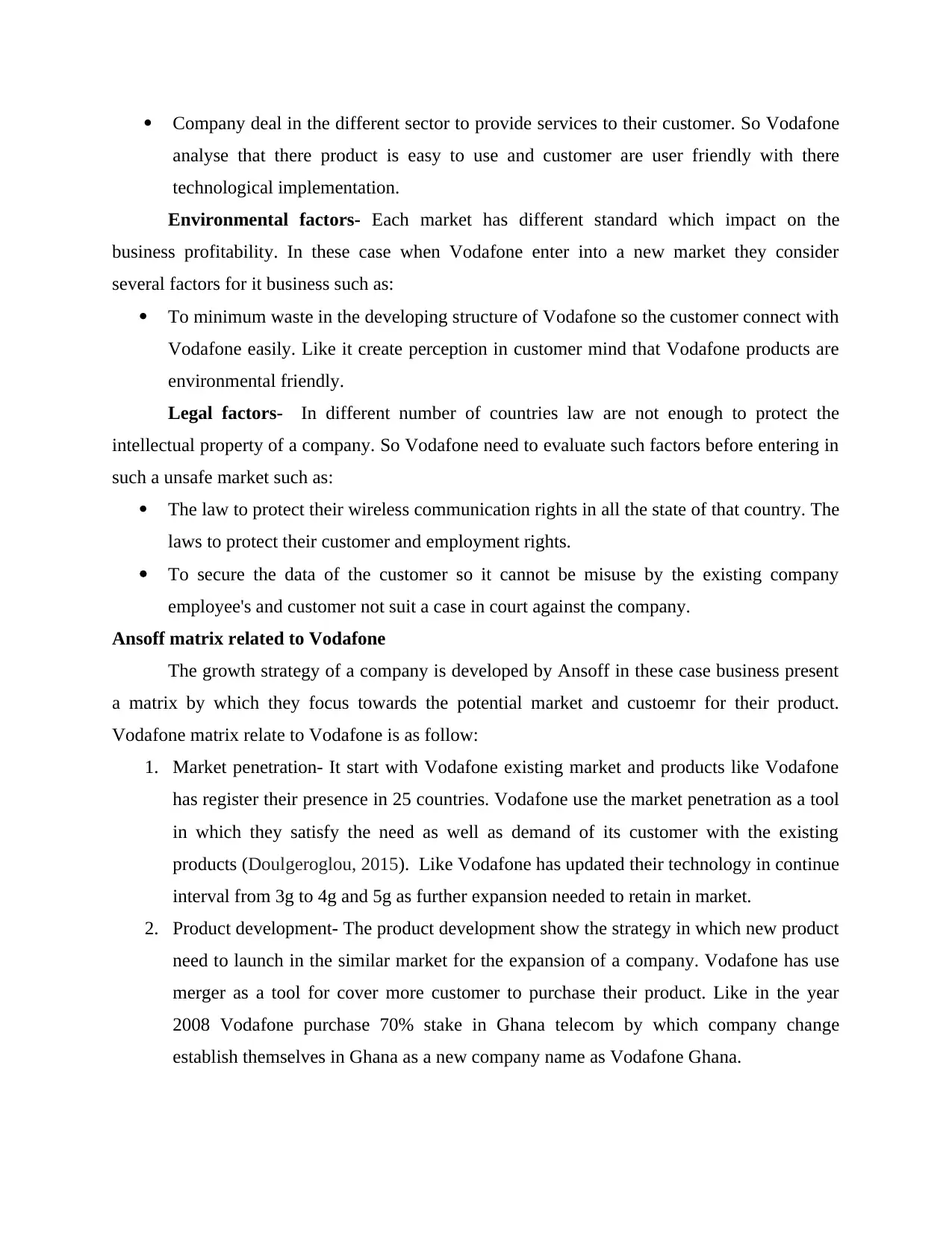
Company deal in the different sector to provide services to their customer. So Vodafone
analyse that there product is easy to use and customer are user friendly with there
technological implementation.
Environmental factors- Each market has different standard which impact on the
business profitability. In these case when Vodafone enter into a new market they consider
several factors for it business such as:
To minimum waste in the developing structure of Vodafone so the customer connect with
Vodafone easily. Like it create perception in customer mind that Vodafone products are
environmental friendly.
Legal factors- In different number of countries law are not enough to protect the
intellectual property of a company. So Vodafone need to evaluate such factors before entering in
such a unsafe market such as:
The law to protect their wireless communication rights in all the state of that country. The
laws to protect their customer and employment rights.
To secure the data of the customer so it cannot be misuse by the existing company
employee's and customer not suit a case in court against the company.
Ansoff matrix related to Vodafone
The growth strategy of a company is developed by Ansoff in these case business present
a matrix by which they focus towards the potential market and custoemr for their product.
Vodafone matrix relate to Vodafone is as follow:
1. Market penetration- It start with Vodafone existing market and products like Vodafone
has register their presence in 25 countries. Vodafone use the market penetration as a tool
in which they satisfy the need as well as demand of its customer with the existing
products (Doulgeroglou, 2015). Like Vodafone has updated their technology in continue
interval from 3g to 4g and 5g as further expansion needed to retain in market.
2. Product development- The product development show the strategy in which new product
need to launch in the similar market for the expansion of a company. Vodafone has use
merger as a tool for cover more customer to purchase their product. Like in the year
2008 Vodafone purchase 70% stake in Ghana telecom by which company change
establish themselves in Ghana as a new company name as Vodafone Ghana.
analyse that there product is easy to use and customer are user friendly with there
technological implementation.
Environmental factors- Each market has different standard which impact on the
business profitability. In these case when Vodafone enter into a new market they consider
several factors for it business such as:
To minimum waste in the developing structure of Vodafone so the customer connect with
Vodafone easily. Like it create perception in customer mind that Vodafone products are
environmental friendly.
Legal factors- In different number of countries law are not enough to protect the
intellectual property of a company. So Vodafone need to evaluate such factors before entering in
such a unsafe market such as:
The law to protect their wireless communication rights in all the state of that country. The
laws to protect their customer and employment rights.
To secure the data of the customer so it cannot be misuse by the existing company
employee's and customer not suit a case in court against the company.
Ansoff matrix related to Vodafone
The growth strategy of a company is developed by Ansoff in these case business present
a matrix by which they focus towards the potential market and custoemr for their product.
Vodafone matrix relate to Vodafone is as follow:
1. Market penetration- It start with Vodafone existing market and products like Vodafone
has register their presence in 25 countries. Vodafone use the market penetration as a tool
in which they satisfy the need as well as demand of its customer with the existing
products (Doulgeroglou, 2015). Like Vodafone has updated their technology in continue
interval from 3g to 4g and 5g as further expansion needed to retain in market.
2. Product development- The product development show the strategy in which new product
need to launch in the similar market for the expansion of a company. Vodafone has use
merger as a tool for cover more customer to purchase their product. Like in the year
2008 Vodafone purchase 70% stake in Ghana telecom by which company change
establish themselves in Ghana as a new company name as Vodafone Ghana.
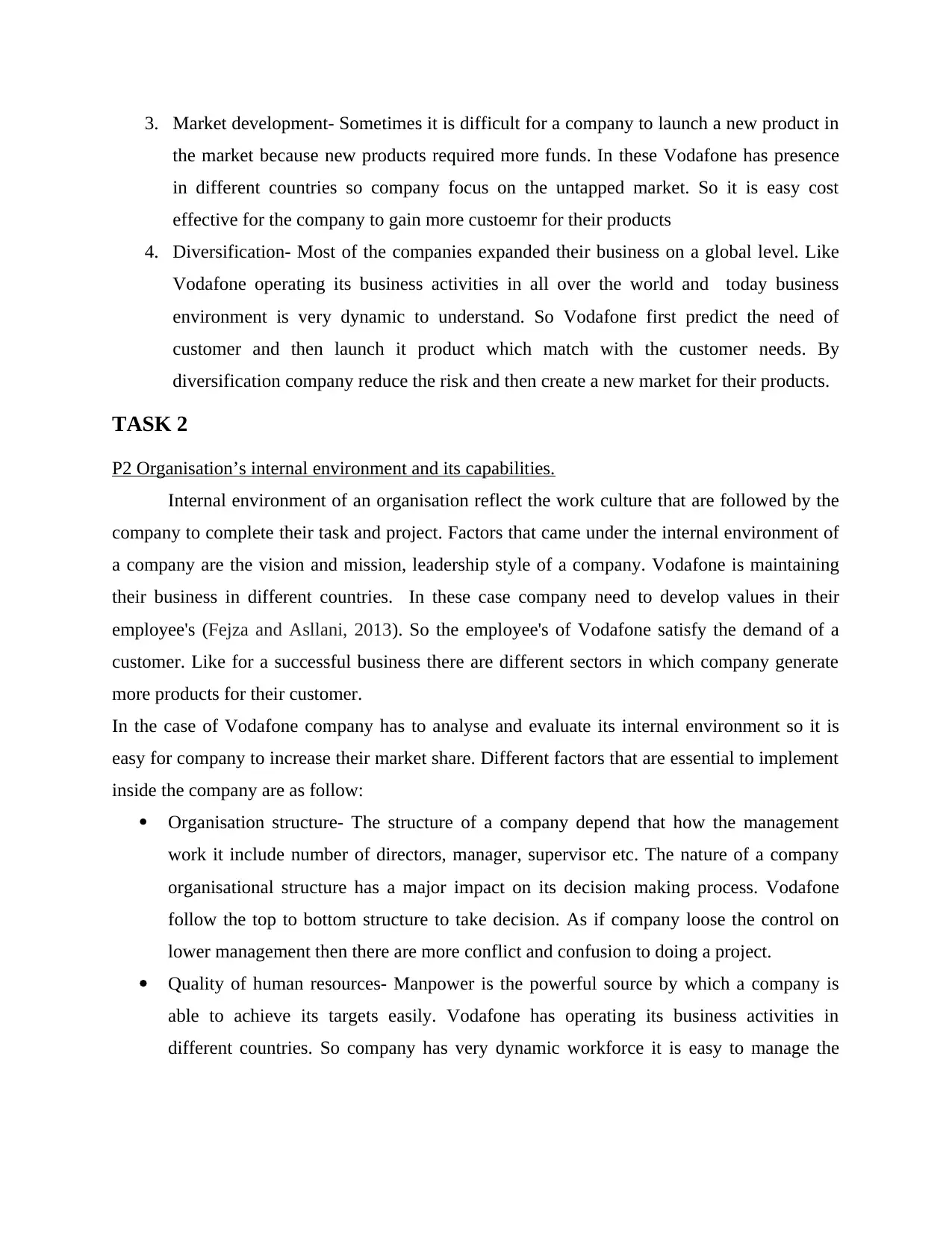
3. Market development- Sometimes it is difficult for a company to launch a new product in
the market because new products required more funds. In these Vodafone has presence
in different countries so company focus on the untapped market. So it is easy cost
effective for the company to gain more custoemr for their products
4. Diversification- Most of the companies expanded their business on a global level. Like
Vodafone operating its business activities in all over the world and today business
environment is very dynamic to understand. So Vodafone first predict the need of
customer and then launch it product which match with the customer needs. By
diversification company reduce the risk and then create a new market for their products.
TASK 2
P2 Organisation’s internal environment and its capabilities.
Internal environment of an organisation reflect the work culture that are followed by the
company to complete their task and project. Factors that came under the internal environment of
a company are the vision and mission, leadership style of a company. Vodafone is maintaining
their business in different countries. In these case company need to develop values in their
employee's (Fejza and Asllani, 2013). So the employee's of Vodafone satisfy the demand of a
customer. Like for a successful business there are different sectors in which company generate
more products for their customer.
In the case of Vodafone company has to analyse and evaluate its internal environment so it is
easy for company to increase their market share. Different factors that are essential to implement
inside the company are as follow:
Organisation structure- The structure of a company depend that how the management
work it include number of directors, manager, supervisor etc. The nature of a company
organisational structure has a major impact on its decision making process. Vodafone
follow the top to bottom structure to take decision. As if company loose the control on
lower management then there are more conflict and confusion to doing a project.
Quality of human resources- Manpower is the powerful source by which a company is
able to achieve its targets easily. Vodafone has operating its business activities in
different countries. So company has very dynamic workforce it is easy to manage the
the market because new products required more funds. In these Vodafone has presence
in different countries so company focus on the untapped market. So it is easy cost
effective for the company to gain more custoemr for their products
4. Diversification- Most of the companies expanded their business on a global level. Like
Vodafone operating its business activities in all over the world and today business
environment is very dynamic to understand. So Vodafone first predict the need of
customer and then launch it product which match with the customer needs. By
diversification company reduce the risk and then create a new market for their products.
TASK 2
P2 Organisation’s internal environment and its capabilities.
Internal environment of an organisation reflect the work culture that are followed by the
company to complete their task and project. Factors that came under the internal environment of
a company are the vision and mission, leadership style of a company. Vodafone is maintaining
their business in different countries. In these case company need to develop values in their
employee's (Fejza and Asllani, 2013). So the employee's of Vodafone satisfy the demand of a
customer. Like for a successful business there are different sectors in which company generate
more products for their customer.
In the case of Vodafone company has to analyse and evaluate its internal environment so it is
easy for company to increase their market share. Different factors that are essential to implement
inside the company are as follow:
Organisation structure- The structure of a company depend that how the management
work it include number of directors, manager, supervisor etc. The nature of a company
organisational structure has a major impact on its decision making process. Vodafone
follow the top to bottom structure to take decision. As if company loose the control on
lower management then there are more conflict and confusion to doing a project.
Quality of human resources- Manpower is the powerful source by which a company is
able to achieve its targets easily. Vodafone has operating its business activities in
different countries. So company has very dynamic workforce it is easy to manage the
Paraphrase This Document
Need a fresh take? Get an instant paraphrase of this document with our AI Paraphraser
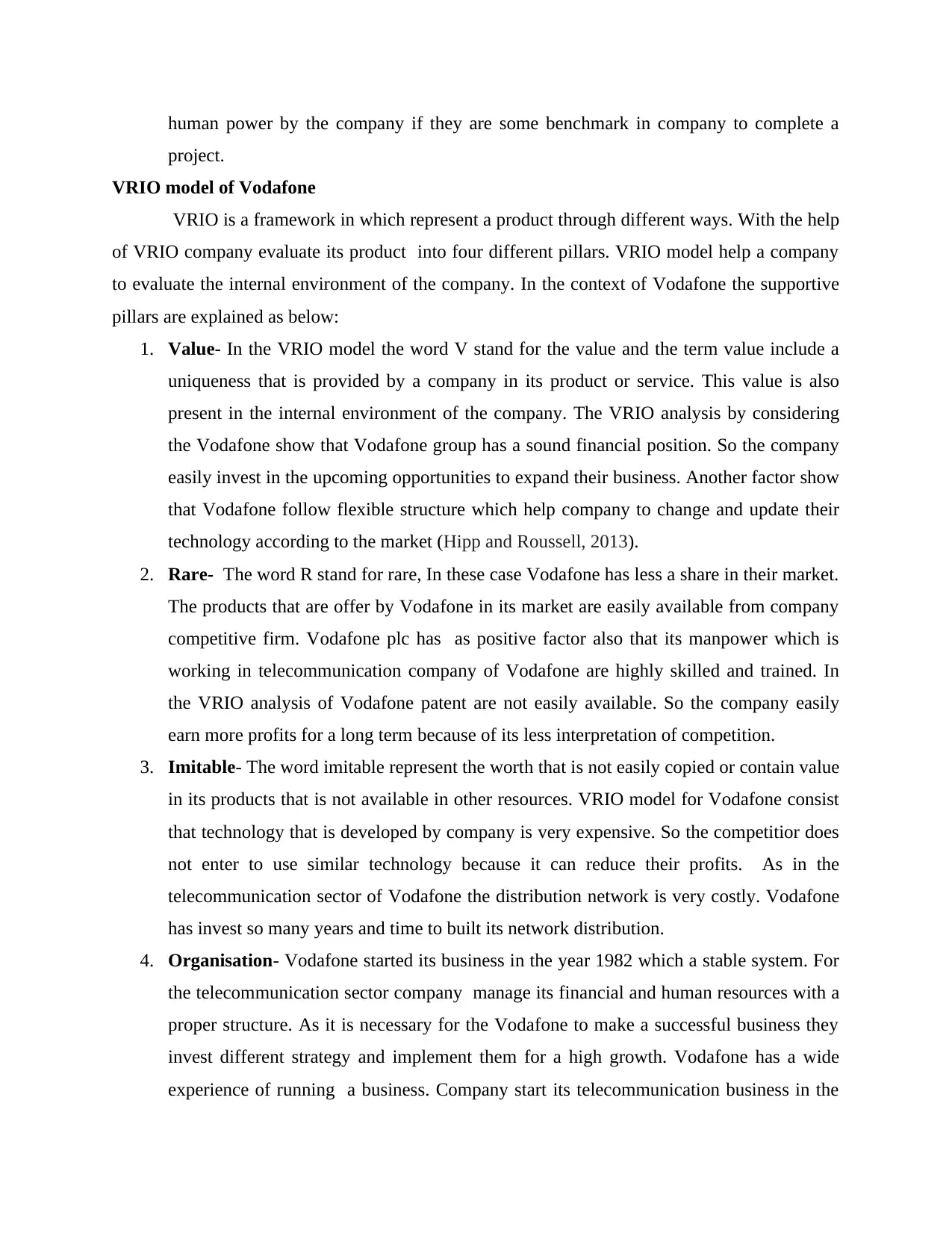
human power by the company if they are some benchmark in company to complete a
project.
VRIO model of Vodafone
VRIO is a framework in which represent a product through different ways. With the help
of VRIO company evaluate its product into four different pillars. VRIO model help a company
to evaluate the internal environment of the company. In the context of Vodafone the supportive
pillars are explained as below:
1. Value- In the VRIO model the word V stand for the value and the term value include a
uniqueness that is provided by a company in its product or service. This value is also
present in the internal environment of the company. The VRIO analysis by considering
the Vodafone show that Vodafone group has a sound financial position. So the company
easily invest in the upcoming opportunities to expand their business. Another factor show
that Vodafone follow flexible structure which help company to change and update their
technology according to the market (Hipp and Roussell, 2013).
2. Rare- The word R stand for rare, In these case Vodafone has less a share in their market.
The products that are offer by Vodafone in its market are easily available from company
competitive firm. Vodafone plc has as positive factor also that its manpower which is
working in telecommunication company of Vodafone are highly skilled and trained. In
the VRIO analysis of Vodafone patent are not easily available. So the company easily
earn more profits for a long term because of its less interpretation of competition.
3. Imitable- The word imitable represent the worth that is not easily copied or contain value
in its products that is not available in other resources. VRIO model for Vodafone consist
that technology that is developed by company is very expensive. So the competitior does
not enter to use similar technology because it can reduce their profits. As in the
telecommunication sector of Vodafone the distribution network is very costly. Vodafone
has invest so many years and time to built its network distribution.
4. Organisation- Vodafone started its business in the year 1982 which a stable system. For
the telecommunication sector company manage its financial and human resources with a
proper structure. As it is necessary for the Vodafone to make a successful business they
invest different strategy and implement them for a high growth. Vodafone has a wide
experience of running a business. Company start its telecommunication business in the
project.
VRIO model of Vodafone
VRIO is a framework in which represent a product through different ways. With the help
of VRIO company evaluate its product into four different pillars. VRIO model help a company
to evaluate the internal environment of the company. In the context of Vodafone the supportive
pillars are explained as below:
1. Value- In the VRIO model the word V stand for the value and the term value include a
uniqueness that is provided by a company in its product or service. This value is also
present in the internal environment of the company. The VRIO analysis by considering
the Vodafone show that Vodafone group has a sound financial position. So the company
easily invest in the upcoming opportunities to expand their business. Another factor show
that Vodafone follow flexible structure which help company to change and update their
technology according to the market (Hipp and Roussell, 2013).
2. Rare- The word R stand for rare, In these case Vodafone has less a share in their market.
The products that are offer by Vodafone in its market are easily available from company
competitive firm. Vodafone plc has as positive factor also that its manpower which is
working in telecommunication company of Vodafone are highly skilled and trained. In
the VRIO analysis of Vodafone patent are not easily available. So the company easily
earn more profits for a long term because of its less interpretation of competition.
3. Imitable- The word imitable represent the worth that is not easily copied or contain value
in its products that is not available in other resources. VRIO model for Vodafone consist
that technology that is developed by company is very expensive. So the competitior does
not enter to use similar technology because it can reduce their profits. As in the
telecommunication sector of Vodafone the distribution network is very costly. Vodafone
has invest so many years and time to built its network distribution.
4. Organisation- Vodafone started its business in the year 1982 which a stable system. For
the telecommunication sector company manage its financial and human resources with a
proper structure. As it is necessary for the Vodafone to make a successful business they
invest different strategy and implement them for a high growth. Vodafone has a wide
experience of running a business. Company start its telecommunication business in the
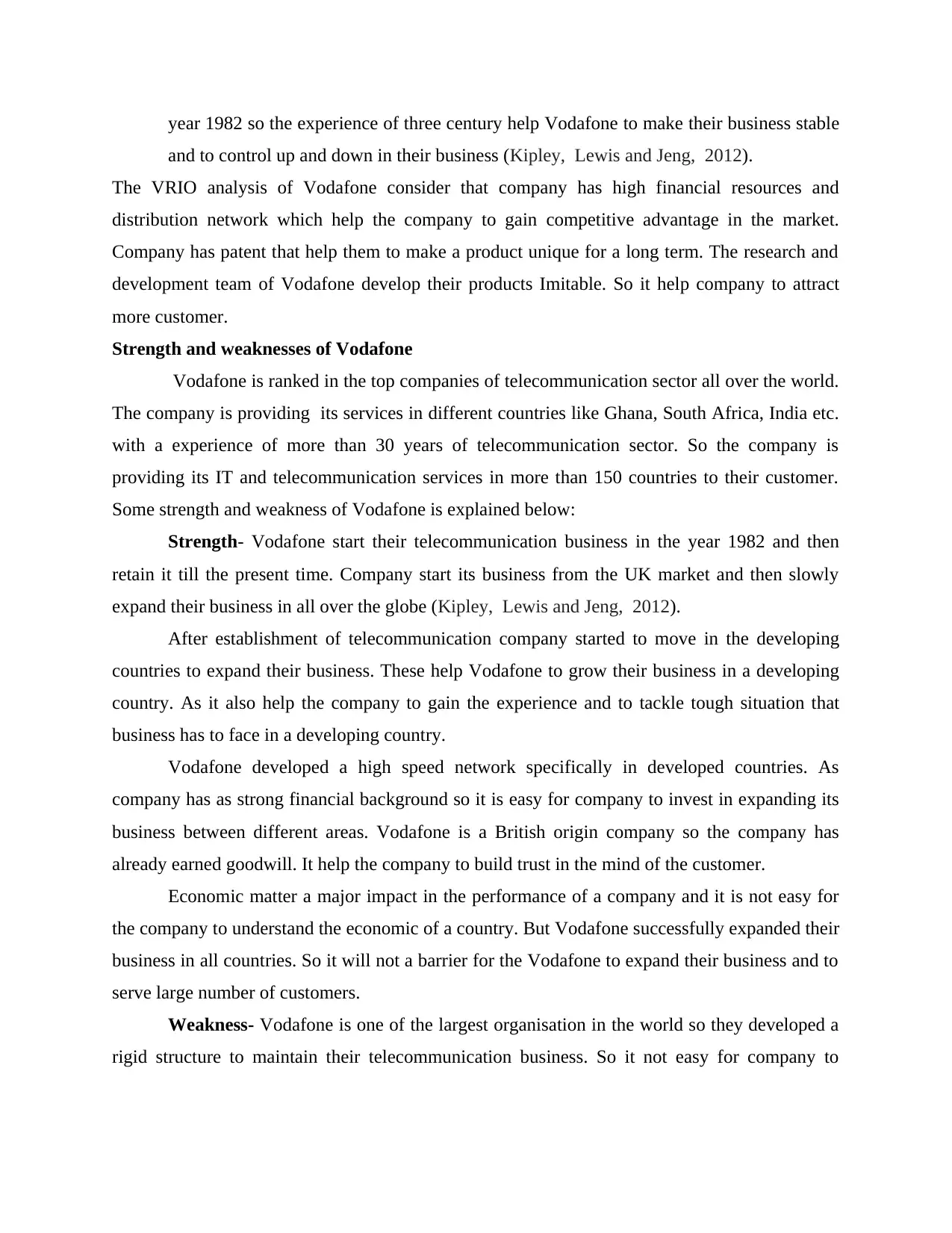
year 1982 so the experience of three century help Vodafone to make their business stable
and to control up and down in their business (Kipley, Lewis and Jeng, 2012).
The VRIO analysis of Vodafone consider that company has high financial resources and
distribution network which help the company to gain competitive advantage in the market.
Company has patent that help them to make a product unique for a long term. The research and
development team of Vodafone develop their products Imitable. So it help company to attract
more customer.
Strength and weaknesses of Vodafone
Vodafone is ranked in the top companies of telecommunication sector all over the world.
The company is providing its services in different countries like Ghana, South Africa, India etc.
with a experience of more than 30 years of telecommunication sector. So the company is
providing its IT and telecommunication services in more than 150 countries to their customer.
Some strength and weakness of Vodafone is explained below:
Strength- Vodafone start their telecommunication business in the year 1982 and then
retain it till the present time. Company start its business from the UK market and then slowly
expand their business in all over the globe (Kipley, Lewis and Jeng, 2012).
After establishment of telecommunication company started to move in the developing
countries to expand their business. These help Vodafone to grow their business in a developing
country. As it also help the company to gain the experience and to tackle tough situation that
business has to face in a developing country.
Vodafone developed a high speed network specifically in developed countries. As
company has as strong financial background so it is easy for company to invest in expanding its
business between different areas. Vodafone is a British origin company so the company has
already earned goodwill. It help the company to build trust in the mind of the customer.
Economic matter a major impact in the performance of a company and it is not easy for
the company to understand the economic of a country. But Vodafone successfully expanded their
business in all countries. So it will not a barrier for the Vodafone to expand their business and to
serve large number of customers.
Weakness- Vodafone is one of the largest organisation in the world so they developed a
rigid structure to maintain their telecommunication business. So it not easy for company to
and to control up and down in their business (Kipley, Lewis and Jeng, 2012).
The VRIO analysis of Vodafone consider that company has high financial resources and
distribution network which help the company to gain competitive advantage in the market.
Company has patent that help them to make a product unique for a long term. The research and
development team of Vodafone develop their products Imitable. So it help company to attract
more customer.
Strength and weaknesses of Vodafone
Vodafone is ranked in the top companies of telecommunication sector all over the world.
The company is providing its services in different countries like Ghana, South Africa, India etc.
with a experience of more than 30 years of telecommunication sector. So the company is
providing its IT and telecommunication services in more than 150 countries to their customer.
Some strength and weakness of Vodafone is explained below:
Strength- Vodafone start their telecommunication business in the year 1982 and then
retain it till the present time. Company start its business from the UK market and then slowly
expand their business in all over the globe (Kipley, Lewis and Jeng, 2012).
After establishment of telecommunication company started to move in the developing
countries to expand their business. These help Vodafone to grow their business in a developing
country. As it also help the company to gain the experience and to tackle tough situation that
business has to face in a developing country.
Vodafone developed a high speed network specifically in developed countries. As
company has as strong financial background so it is easy for company to invest in expanding its
business between different areas. Vodafone is a British origin company so the company has
already earned goodwill. It help the company to build trust in the mind of the customer.
Economic matter a major impact in the performance of a company and it is not easy for
the company to understand the economic of a country. But Vodafone successfully expanded their
business in all countries. So it will not a barrier for the Vodafone to expand their business and to
serve large number of customers.
Weakness- Vodafone is one of the largest organisation in the world so they developed a
rigid structure to maintain their telecommunication business. So it not easy for company to
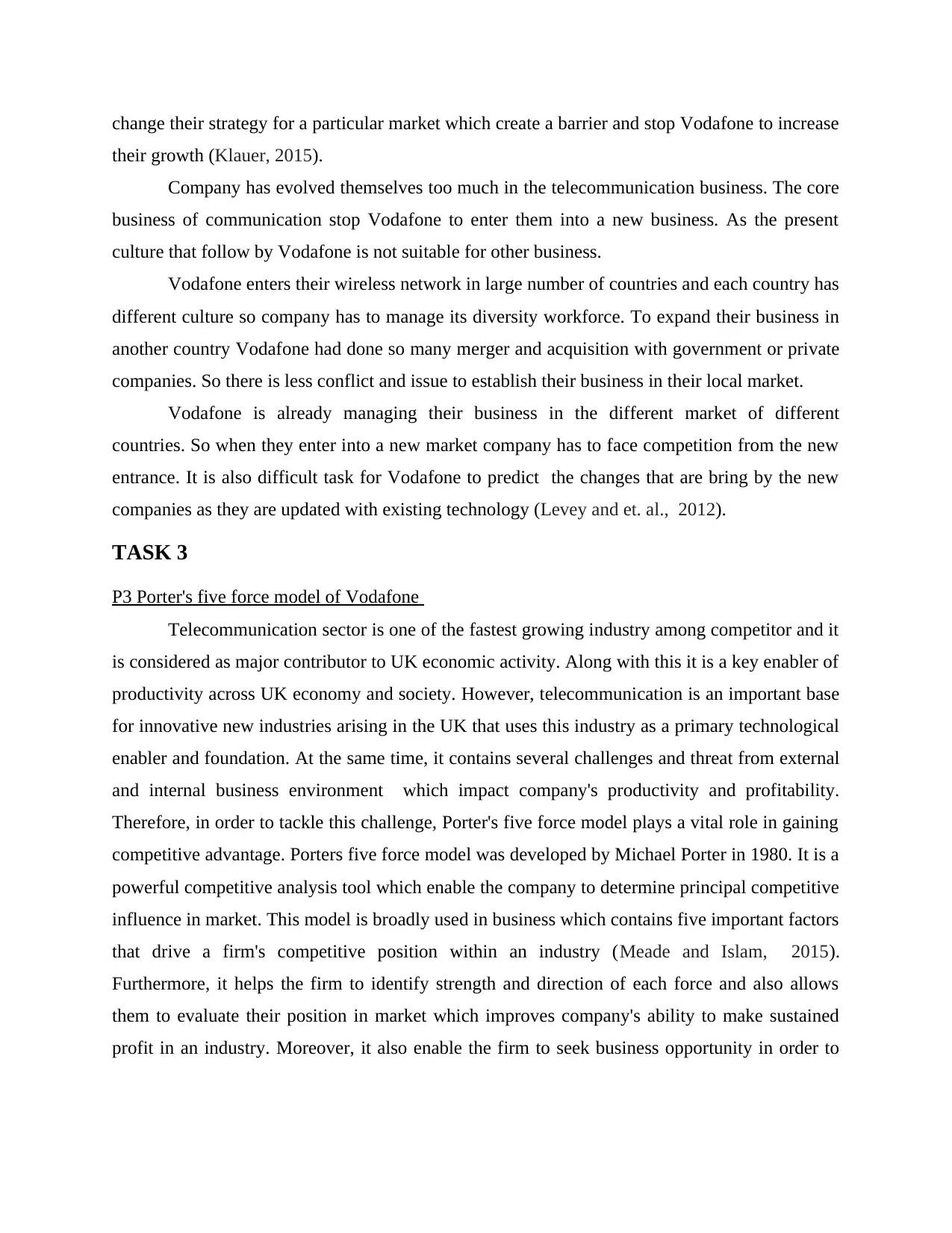
change their strategy for a particular market which create a barrier and stop Vodafone to increase
their growth (Klauer, 2015).
Company has evolved themselves too much in the telecommunication business. The core
business of communication stop Vodafone to enter them into a new business. As the present
culture that follow by Vodafone is not suitable for other business.
Vodafone enters their wireless network in large number of countries and each country has
different culture so company has to manage its diversity workforce. To expand their business in
another country Vodafone had done so many merger and acquisition with government or private
companies. So there is less conflict and issue to establish their business in their local market.
Vodafone is already managing their business in the different market of different
countries. So when they enter into a new market company has to face competition from the new
entrance. It is also difficult task for Vodafone to predict the changes that are bring by the new
companies as they are updated with existing technology (Levey and et. al., 2012).
TASK 3
P3 Porter's five force model of Vodafone
Telecommunication sector is one of the fastest growing industry among competitor and it
is considered as major contributor to UK economic activity. Along with this it is a key enabler of
productivity across UK economy and society. However, telecommunication is an important base
for innovative new industries arising in the UK that uses this industry as a primary technological
enabler and foundation. At the same time, it contains several challenges and threat from external
and internal business environment which impact company's productivity and profitability.
Therefore, in order to tackle this challenge, Porter's five force model plays a vital role in gaining
competitive advantage. Porters five force model was developed by Michael Porter in 1980. It is a
powerful competitive analysis tool which enable the company to determine principal competitive
influence in market. This model is broadly used in business which contains five important factors
that drive a firm's competitive position within an industry (Meade and Islam, 2015).
Furthermore, it helps the firm to identify strength and direction of each force and also allows
them to evaluate their position in market which improves company's ability to make sustained
profit in an industry. Moreover, it also enable the firm to seek business opportunity in order to
their growth (Klauer, 2015).
Company has evolved themselves too much in the telecommunication business. The core
business of communication stop Vodafone to enter them into a new business. As the present
culture that follow by Vodafone is not suitable for other business.
Vodafone enters their wireless network in large number of countries and each country has
different culture so company has to manage its diversity workforce. To expand their business in
another country Vodafone had done so many merger and acquisition with government or private
companies. So there is less conflict and issue to establish their business in their local market.
Vodafone is already managing their business in the different market of different
countries. So when they enter into a new market company has to face competition from the new
entrance. It is also difficult task for Vodafone to predict the changes that are bring by the new
companies as they are updated with existing technology (Levey and et. al., 2012).
TASK 3
P3 Porter's five force model of Vodafone
Telecommunication sector is one of the fastest growing industry among competitor and it
is considered as major contributor to UK economic activity. Along with this it is a key enabler of
productivity across UK economy and society. However, telecommunication is an important base
for innovative new industries arising in the UK that uses this industry as a primary technological
enabler and foundation. At the same time, it contains several challenges and threat from external
and internal business environment which impact company's productivity and profitability.
Therefore, in order to tackle this challenge, Porter's five force model plays a vital role in gaining
competitive advantage. Porters five force model was developed by Michael Porter in 1980. It is a
powerful competitive analysis tool which enable the company to determine principal competitive
influence in market. This model is broadly used in business which contains five important factors
that drive a firm's competitive position within an industry (Meade and Islam, 2015).
Furthermore, it helps the firm to identify strength and direction of each force and also allows
them to evaluate their position in market which improves company's ability to make sustained
profit in an industry. Moreover, it also enable the firm to seek business opportunity in order to
Secure Best Marks with AI Grader
Need help grading? Try our AI Grader for instant feedback on your assignments.
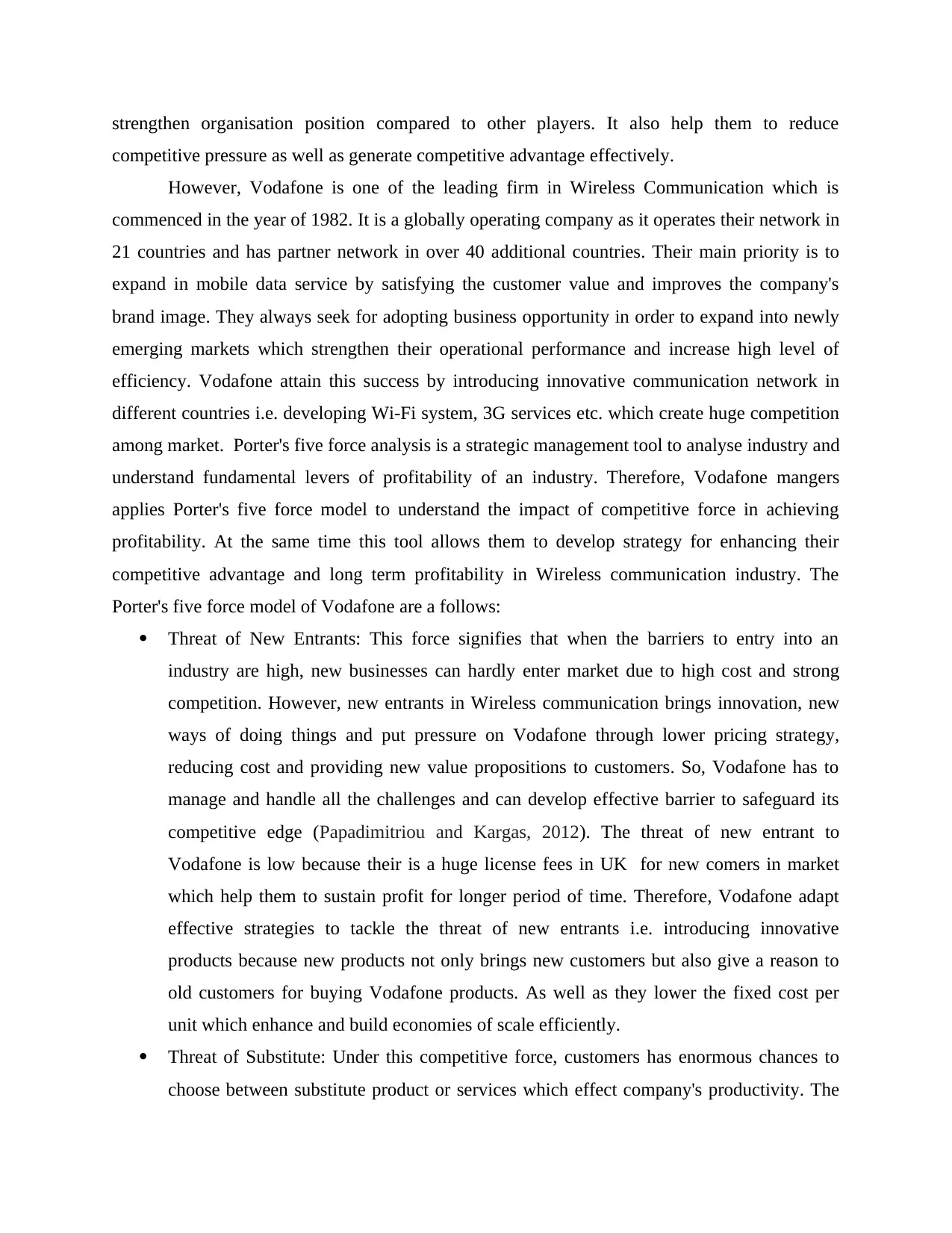
strengthen organisation position compared to other players. It also help them to reduce
competitive pressure as well as generate competitive advantage effectively.
However, Vodafone is one of the leading firm in Wireless Communication which is
commenced in the year of 1982. It is a globally operating company as it operates their network in
21 countries and has partner network in over 40 additional countries. Their main priority is to
expand in mobile data service by satisfying the customer value and improves the company's
brand image. They always seek for adopting business opportunity in order to expand into newly
emerging markets which strengthen their operational performance and increase high level of
efficiency. Vodafone attain this success by introducing innovative communication network in
different countries i.e. developing Wi-Fi system, 3G services etc. which create huge competition
among market. Porter's five force analysis is a strategic management tool to analyse industry and
understand fundamental levers of profitability of an industry. Therefore, Vodafone mangers
applies Porter's five force model to understand the impact of competitive force in achieving
profitability. At the same time this tool allows them to develop strategy for enhancing their
competitive advantage and long term profitability in Wireless communication industry. The
Porter's five force model of Vodafone are a follows:
Threat of New Entrants: This force signifies that when the barriers to entry into an
industry are high, new businesses can hardly enter market due to high cost and strong
competition. However, new entrants in Wireless communication brings innovation, new
ways of doing things and put pressure on Vodafone through lower pricing strategy,
reducing cost and providing new value propositions to customers. So, Vodafone has to
manage and handle all the challenges and can develop effective barrier to safeguard its
competitive edge (Papadimitriou and Kargas, 2012). The threat of new entrant to
Vodafone is low because their is a huge license fees in UK for new comers in market
which help them to sustain profit for longer period of time. Therefore, Vodafone adapt
effective strategies to tackle the threat of new entrants i.e. introducing innovative
products because new products not only brings new customers but also give a reason to
old customers for buying Vodafone products. As well as they lower the fixed cost per
unit which enhance and build economies of scale efficiently.
Threat of Substitute: Under this competitive force, customers has enormous chances to
choose between substitute product or services which effect company's productivity. The
competitive pressure as well as generate competitive advantage effectively.
However, Vodafone is one of the leading firm in Wireless Communication which is
commenced in the year of 1982. It is a globally operating company as it operates their network in
21 countries and has partner network in over 40 additional countries. Their main priority is to
expand in mobile data service by satisfying the customer value and improves the company's
brand image. They always seek for adopting business opportunity in order to expand into newly
emerging markets which strengthen their operational performance and increase high level of
efficiency. Vodafone attain this success by introducing innovative communication network in
different countries i.e. developing Wi-Fi system, 3G services etc. which create huge competition
among market. Porter's five force analysis is a strategic management tool to analyse industry and
understand fundamental levers of profitability of an industry. Therefore, Vodafone mangers
applies Porter's five force model to understand the impact of competitive force in achieving
profitability. At the same time this tool allows them to develop strategy for enhancing their
competitive advantage and long term profitability in Wireless communication industry. The
Porter's five force model of Vodafone are a follows:
Threat of New Entrants: This force signifies that when the barriers to entry into an
industry are high, new businesses can hardly enter market due to high cost and strong
competition. However, new entrants in Wireless communication brings innovation, new
ways of doing things and put pressure on Vodafone through lower pricing strategy,
reducing cost and providing new value propositions to customers. So, Vodafone has to
manage and handle all the challenges and can develop effective barrier to safeguard its
competitive edge (Papadimitriou and Kargas, 2012). The threat of new entrant to
Vodafone is low because their is a huge license fees in UK for new comers in market
which help them to sustain profit for longer period of time. Therefore, Vodafone adapt
effective strategies to tackle the threat of new entrants i.e. introducing innovative
products because new products not only brings new customers but also give a reason to
old customers for buying Vodafone products. As well as they lower the fixed cost per
unit which enhance and build economies of scale efficiently.
Threat of Substitute: Under this competitive force, customers has enormous chances to
choose between substitute product or services which effect company's productivity. The

threat of substitutes of Vodafone is medium to high in UK market that becomes a major
threat to them and it effected the consumer buying behaviour. However, Vodafone
overcome this challenge effectively as they mainly focused on service oriented rather
than product oriented as well they understand the core need of customer rather than what
they buying. Along with this, they increased the switching cost for customer and very few
companies provides 3G card or DSL services in UK which enable them to maintain their
proficiency in market (Vodafone Group Plc , Porter's Five Forces, 2019).
Bargaining Power of Suppliers: It signifies the extent in which suppliers influences the
prices. Most of the UK companies in wireless communication industry buy their raw
material from varies suppliers. Suppliers in dominant position decreases the profit margin
of Vodafone as they use their negotiating power to extract high price from companies in
Wireless Communication. Therefore, Vodafone implies effective solution to tackle
bargaining power of suppliers by building efficient supply chain with several suppliers as
well as developing dedicated suppliers i.e. third party whose business is totally depend
upon the Vodafone where those manufacturers have less bargaining power and it enrich
the competitive advantage of Vodafone.
Bargaining power of Buyers: This force concerned with the ability of customer to bargain
the product on the basis of price and quality. Buyers often demand a lot and its varies
from time to time as they always want to buy best offer by paying minimum price as
possible. This put pressure and challenge on Vodafone's profitability in the long run.
Although, bargaining power of customers in Vodafone is high because of high
competition in telecom industry. Therefore, they acquire impressive and productive
tactics in order to overcome this pressure (Reddy, 2015). Customers mainly seek for
discounts and new brands so,Vodafone introduce innovative products with impressive
discounts and features which limits the bargaining power of buyers as well as new
products reduce the defection of existing customer of Vodafone to its competitors. Along
with this, they develop a large base of customers which helps them in decreasing the
bargaining power of buyers as well as provide an opportunity to Vodafone for streamline
their sales and production process.
Rivalry among competitors: In case of high competitive industry, companies can have
little or no control over the price of goods and services. On the other hand, if an industry
threat to them and it effected the consumer buying behaviour. However, Vodafone
overcome this challenge effectively as they mainly focused on service oriented rather
than product oriented as well they understand the core need of customer rather than what
they buying. Along with this, they increased the switching cost for customer and very few
companies provides 3G card or DSL services in UK which enable them to maintain their
proficiency in market (Vodafone Group Plc , Porter's Five Forces, 2019).
Bargaining Power of Suppliers: It signifies the extent in which suppliers influences the
prices. Most of the UK companies in wireless communication industry buy their raw
material from varies suppliers. Suppliers in dominant position decreases the profit margin
of Vodafone as they use their negotiating power to extract high price from companies in
Wireless Communication. Therefore, Vodafone implies effective solution to tackle
bargaining power of suppliers by building efficient supply chain with several suppliers as
well as developing dedicated suppliers i.e. third party whose business is totally depend
upon the Vodafone where those manufacturers have less bargaining power and it enrich
the competitive advantage of Vodafone.
Bargaining power of Buyers: This force concerned with the ability of customer to bargain
the product on the basis of price and quality. Buyers often demand a lot and its varies
from time to time as they always want to buy best offer by paying minimum price as
possible. This put pressure and challenge on Vodafone's profitability in the long run.
Although, bargaining power of customers in Vodafone is high because of high
competition in telecom industry. Therefore, they acquire impressive and productive
tactics in order to overcome this pressure (Reddy, 2015). Customers mainly seek for
discounts and new brands so,Vodafone introduce innovative products with impressive
discounts and features which limits the bargaining power of buyers as well as new
products reduce the defection of existing customer of Vodafone to its competitors. Along
with this, they develop a large base of customers which helps them in decreasing the
bargaining power of buyers as well as provide an opportunity to Vodafone for streamline
their sales and production process.
Rivalry among competitors: In case of high competitive industry, companies can have
little or no control over the price of goods and services. On the other hand, if an industry
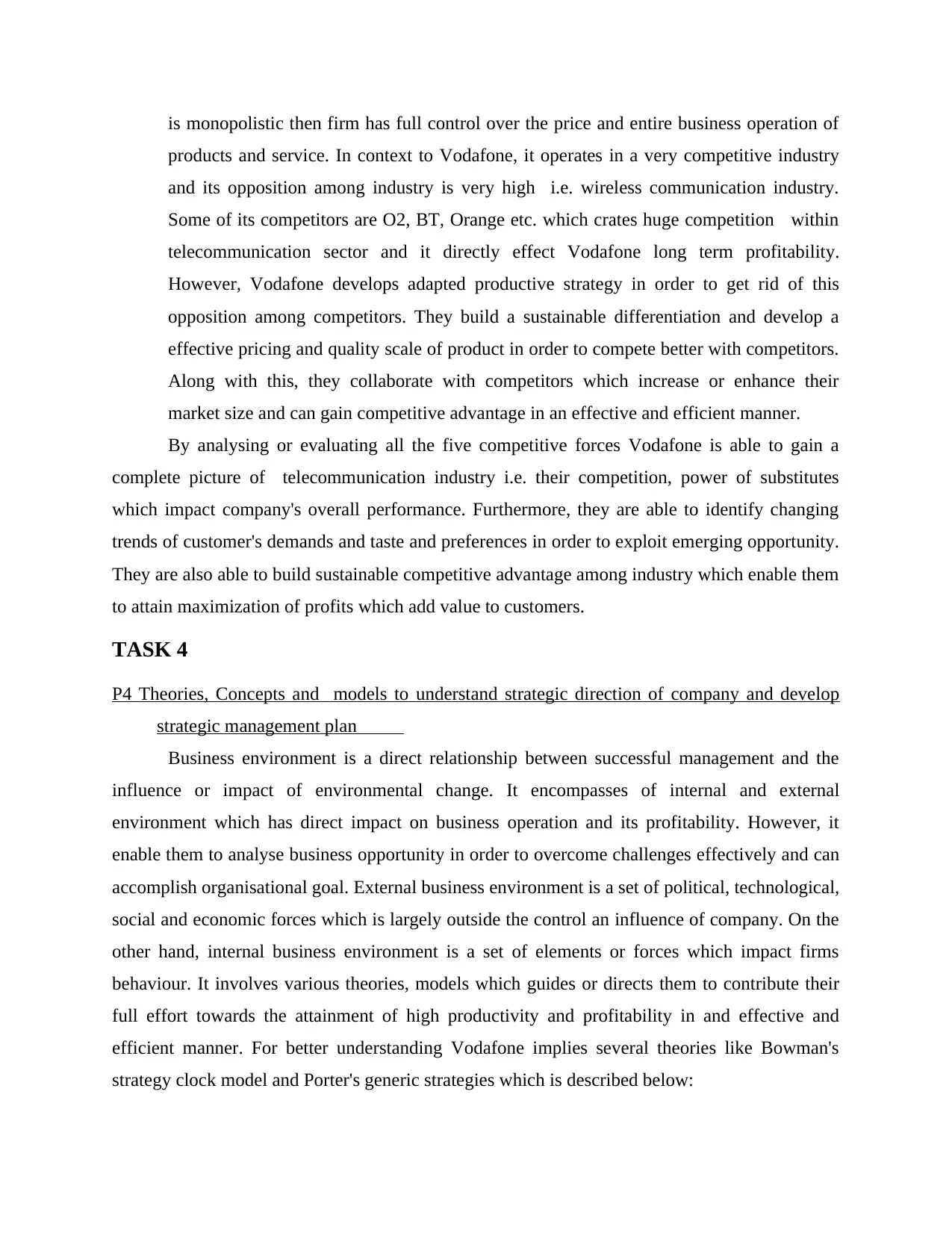
is monopolistic then firm has full control over the price and entire business operation of
products and service. In context to Vodafone, it operates in a very competitive industry
and its opposition among industry is very high i.e. wireless communication industry.
Some of its competitors are O2, BT, Orange etc. which crates huge competition within
telecommunication sector and it directly effect Vodafone long term profitability.
However, Vodafone develops adapted productive strategy in order to get rid of this
opposition among competitors. They build a sustainable differentiation and develop a
effective pricing and quality scale of product in order to compete better with competitors.
Along with this, they collaborate with competitors which increase or enhance their
market size and can gain competitive advantage in an effective and efficient manner.
By analysing or evaluating all the five competitive forces Vodafone is able to gain a
complete picture of telecommunication industry i.e. their competition, power of substitutes
which impact company's overall performance. Furthermore, they are able to identify changing
trends of customer's demands and taste and preferences in order to exploit emerging opportunity.
They are also able to build sustainable competitive advantage among industry which enable them
to attain maximization of profits which add value to customers.
TASK 4
P4 Theories, Concepts and models to understand strategic direction of company and develop
strategic management plan
Business environment is a direct relationship between successful management and the
influence or impact of environmental change. It encompasses of internal and external
environment which has direct impact on business operation and its profitability. However, it
enable them to analyse business opportunity in order to overcome challenges effectively and can
accomplish organisational goal. External business environment is a set of political, technological,
social and economic forces which is largely outside the control an influence of company. On the
other hand, internal business environment is a set of elements or forces which impact firms
behaviour. It involves various theories, models which guides or directs them to contribute their
full effort towards the attainment of high productivity and profitability in and effective and
efficient manner. For better understanding Vodafone implies several theories like Bowman's
strategy clock model and Porter's generic strategies which is described below:
products and service. In context to Vodafone, it operates in a very competitive industry
and its opposition among industry is very high i.e. wireless communication industry.
Some of its competitors are O2, BT, Orange etc. which crates huge competition within
telecommunication sector and it directly effect Vodafone long term profitability.
However, Vodafone develops adapted productive strategy in order to get rid of this
opposition among competitors. They build a sustainable differentiation and develop a
effective pricing and quality scale of product in order to compete better with competitors.
Along with this, they collaborate with competitors which increase or enhance their
market size and can gain competitive advantage in an effective and efficient manner.
By analysing or evaluating all the five competitive forces Vodafone is able to gain a
complete picture of telecommunication industry i.e. their competition, power of substitutes
which impact company's overall performance. Furthermore, they are able to identify changing
trends of customer's demands and taste and preferences in order to exploit emerging opportunity.
They are also able to build sustainable competitive advantage among industry which enable them
to attain maximization of profits which add value to customers.
TASK 4
P4 Theories, Concepts and models to understand strategic direction of company and develop
strategic management plan
Business environment is a direct relationship between successful management and the
influence or impact of environmental change. It encompasses of internal and external
environment which has direct impact on business operation and its profitability. However, it
enable them to analyse business opportunity in order to overcome challenges effectively and can
accomplish organisational goal. External business environment is a set of political, technological,
social and economic forces which is largely outside the control an influence of company. On the
other hand, internal business environment is a set of elements or forces which impact firms
behaviour. It involves various theories, models which guides or directs them to contribute their
full effort towards the attainment of high productivity and profitability in and effective and
efficient manner. For better understanding Vodafone implies several theories like Bowman's
strategy clock model and Porter's generic strategies which is described below:
Paraphrase This Document
Need a fresh take? Get an instant paraphrase of this document with our AI Paraphraser
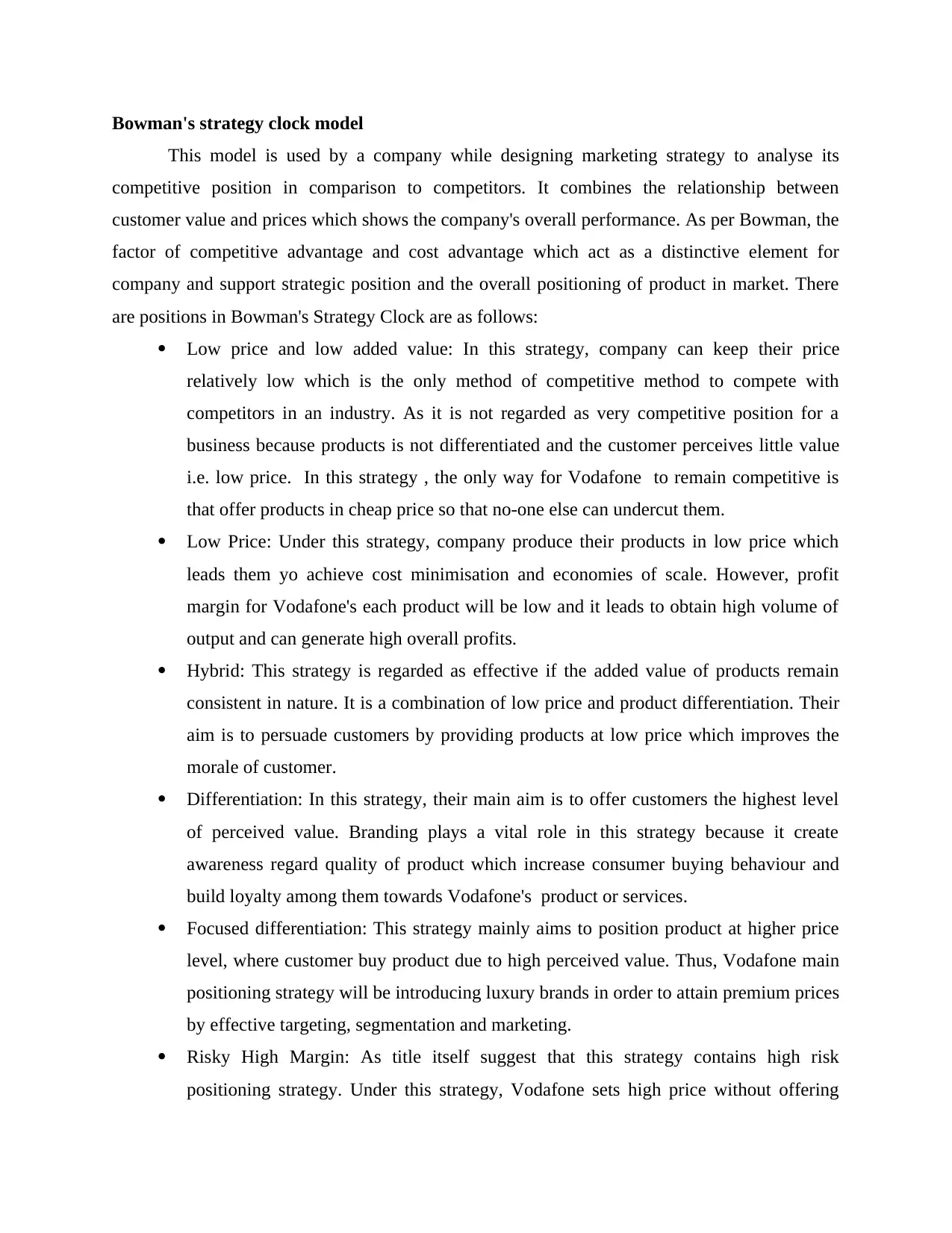
Bowman's strategy clock model
This model is used by a company while designing marketing strategy to analyse its
competitive position in comparison to competitors. It combines the relationship between
customer value and prices which shows the company's overall performance. As per Bowman, the
factor of competitive advantage and cost advantage which act as a distinctive element for
company and support strategic position and the overall positioning of product in market. There
are positions in Bowman's Strategy Clock are as follows:
Low price and low added value: In this strategy, company can keep their price
relatively low which is the only method of competitive method to compete with
competitors in an industry. As it is not regarded as very competitive position for a
business because products is not differentiated and the customer perceives little value
i.e. low price. In this strategy , the only way for Vodafone to remain competitive is
that offer products in cheap price so that no-one else can undercut them.
Low Price: Under this strategy, company produce their products in low price which
leads them yo achieve cost minimisation and economies of scale. However, profit
margin for Vodafone's each product will be low and it leads to obtain high volume of
output and can generate high overall profits.
Hybrid: This strategy is regarded as effective if the added value of products remain
consistent in nature. It is a combination of low price and product differentiation. Their
aim is to persuade customers by providing products at low price which improves the
morale of customer.
Differentiation: In this strategy, their main aim is to offer customers the highest level
of perceived value. Branding plays a vital role in this strategy because it create
awareness regard quality of product which increase consumer buying behaviour and
build loyalty among them towards Vodafone's product or services.
Focused differentiation: This strategy mainly aims to position product at higher price
level, where customer buy product due to high perceived value. Thus, Vodafone main
positioning strategy will be introducing luxury brands in order to attain premium prices
by effective targeting, segmentation and marketing.
Risky High Margin: As title itself suggest that this strategy contains high risk
positioning strategy. Under this strategy, Vodafone sets high price without offering
This model is used by a company while designing marketing strategy to analyse its
competitive position in comparison to competitors. It combines the relationship between
customer value and prices which shows the company's overall performance. As per Bowman, the
factor of competitive advantage and cost advantage which act as a distinctive element for
company and support strategic position and the overall positioning of product in market. There
are positions in Bowman's Strategy Clock are as follows:
Low price and low added value: In this strategy, company can keep their price
relatively low which is the only method of competitive method to compete with
competitors in an industry. As it is not regarded as very competitive position for a
business because products is not differentiated and the customer perceives little value
i.e. low price. In this strategy , the only way for Vodafone to remain competitive is
that offer products in cheap price so that no-one else can undercut them.
Low Price: Under this strategy, company produce their products in low price which
leads them yo achieve cost minimisation and economies of scale. However, profit
margin for Vodafone's each product will be low and it leads to obtain high volume of
output and can generate high overall profits.
Hybrid: This strategy is regarded as effective if the added value of products remain
consistent in nature. It is a combination of low price and product differentiation. Their
aim is to persuade customers by providing products at low price which improves the
morale of customer.
Differentiation: In this strategy, their main aim is to offer customers the highest level
of perceived value. Branding plays a vital role in this strategy because it create
awareness regard quality of product which increase consumer buying behaviour and
build loyalty among them towards Vodafone's product or services.
Focused differentiation: This strategy mainly aims to position product at higher price
level, where customer buy product due to high perceived value. Thus, Vodafone main
positioning strategy will be introducing luxury brands in order to attain premium prices
by effective targeting, segmentation and marketing.
Risky High Margin: As title itself suggest that this strategy contains high risk
positioning strategy. Under this strategy, Vodafone sets high price without offering
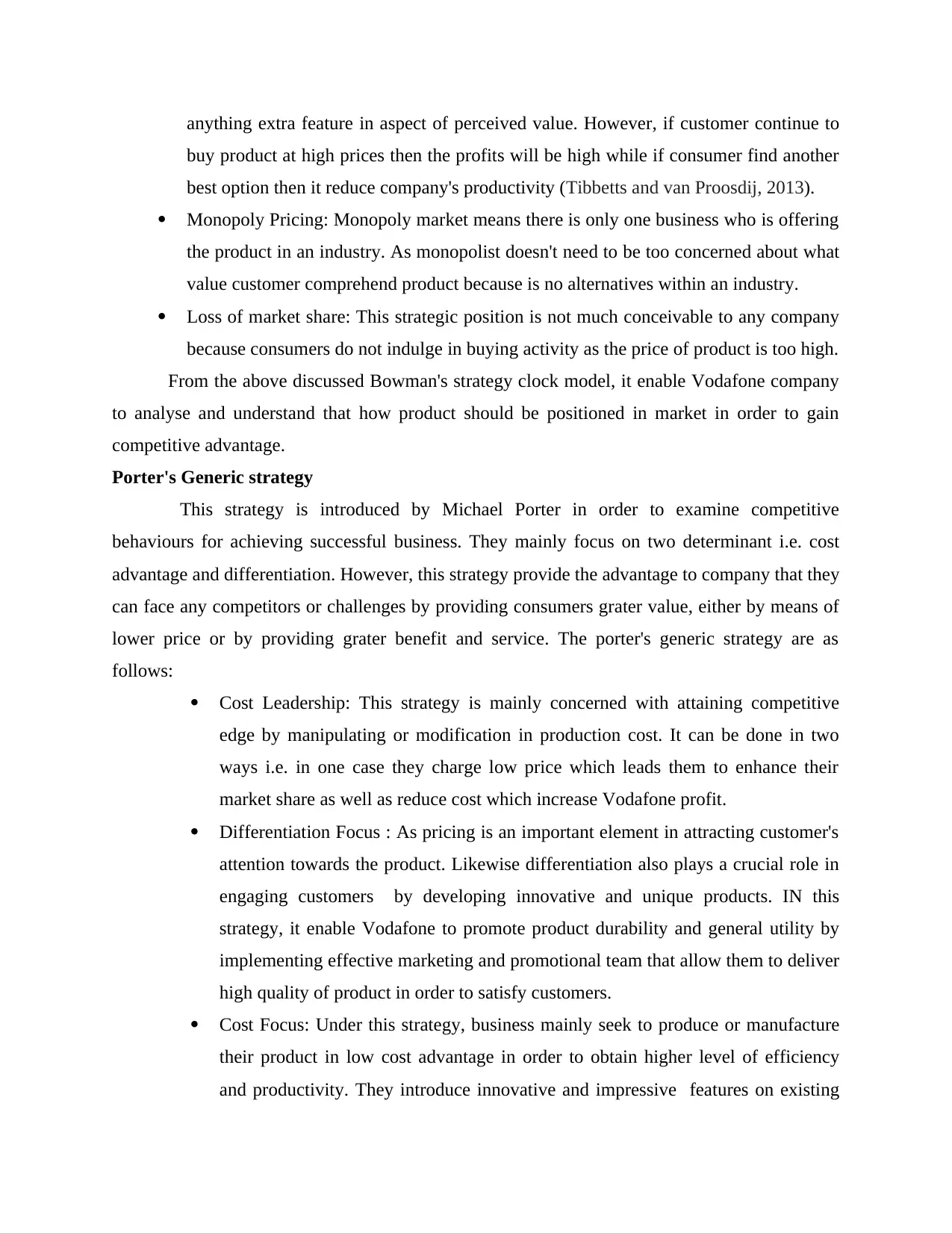
anything extra feature in aspect of perceived value. However, if customer continue to
buy product at high prices then the profits will be high while if consumer find another
best option then it reduce company's productivity (Tibbetts and van Proosdij, 2013).
Monopoly Pricing: Monopoly market means there is only one business who is offering
the product in an industry. As monopolist doesn't need to be too concerned about what
value customer comprehend product because is no alternatives within an industry.
Loss of market share: This strategic position is not much conceivable to any company
because consumers do not indulge in buying activity as the price of product is too high.
From the above discussed Bowman's strategy clock model, it enable Vodafone company
to analyse and understand that how product should be positioned in market in order to gain
competitive advantage.
Porter's Generic strategy
This strategy is introduced by Michael Porter in order to examine competitive
behaviours for achieving successful business. They mainly focus on two determinant i.e. cost
advantage and differentiation. However, this strategy provide the advantage to company that they
can face any competitors or challenges by providing consumers grater value, either by means of
lower price or by providing grater benefit and service. The porter's generic strategy are as
follows:
Cost Leadership: This strategy is mainly concerned with attaining competitive
edge by manipulating or modification in production cost. It can be done in two
ways i.e. in one case they charge low price which leads them to enhance their
market share as well as reduce cost which increase Vodafone profit.
Differentiation Focus : As pricing is an important element in attracting customer's
attention towards the product. Likewise differentiation also plays a crucial role in
engaging customers by developing innovative and unique products. IN this
strategy, it enable Vodafone to promote product durability and general utility by
implementing effective marketing and promotional team that allow them to deliver
high quality of product in order to satisfy customers.
Cost Focus: Under this strategy, business mainly seek to produce or manufacture
their product in low cost advantage in order to obtain higher level of efficiency
and productivity. They introduce innovative and impressive features on existing
buy product at high prices then the profits will be high while if consumer find another
best option then it reduce company's productivity (Tibbetts and van Proosdij, 2013).
Monopoly Pricing: Monopoly market means there is only one business who is offering
the product in an industry. As monopolist doesn't need to be too concerned about what
value customer comprehend product because is no alternatives within an industry.
Loss of market share: This strategic position is not much conceivable to any company
because consumers do not indulge in buying activity as the price of product is too high.
From the above discussed Bowman's strategy clock model, it enable Vodafone company
to analyse and understand that how product should be positioned in market in order to gain
competitive advantage.
Porter's Generic strategy
This strategy is introduced by Michael Porter in order to examine competitive
behaviours for achieving successful business. They mainly focus on two determinant i.e. cost
advantage and differentiation. However, this strategy provide the advantage to company that they
can face any competitors or challenges by providing consumers grater value, either by means of
lower price or by providing grater benefit and service. The porter's generic strategy are as
follows:
Cost Leadership: This strategy is mainly concerned with attaining competitive
edge by manipulating or modification in production cost. It can be done in two
ways i.e. in one case they charge low price which leads them to enhance their
market share as well as reduce cost which increase Vodafone profit.
Differentiation Focus : As pricing is an important element in attracting customer's
attention towards the product. Likewise differentiation also plays a crucial role in
engaging customers by developing innovative and unique products. IN this
strategy, it enable Vodafone to promote product durability and general utility by
implementing effective marketing and promotional team that allow them to deliver
high quality of product in order to satisfy customers.
Cost Focus: Under this strategy, business mainly seek to produce or manufacture
their product in low cost advantage in order to obtain higher level of efficiency
and productivity. They introduce innovative and impressive features on existing
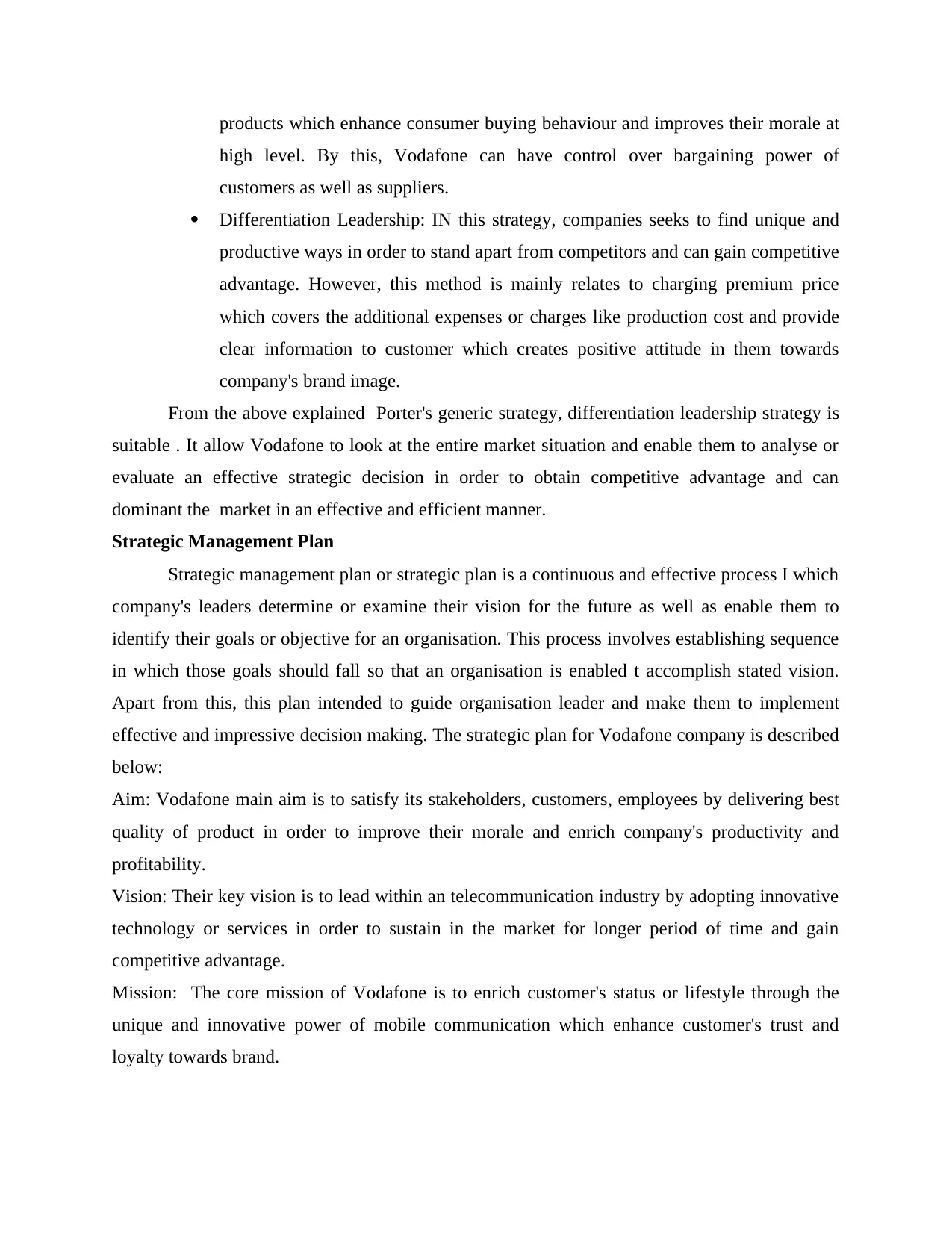
products which enhance consumer buying behaviour and improves their morale at
high level. By this, Vodafone can have control over bargaining power of
customers as well as suppliers.
Differentiation Leadership: IN this strategy, companies seeks to find unique and
productive ways in order to stand apart from competitors and can gain competitive
advantage. However, this method is mainly relates to charging premium price
which covers the additional expenses or charges like production cost and provide
clear information to customer which creates positive attitude in them towards
company's brand image.
From the above explained Porter's generic strategy, differentiation leadership strategy is
suitable . It allow Vodafone to look at the entire market situation and enable them to analyse or
evaluate an effective strategic decision in order to obtain competitive advantage and can
dominant the market in an effective and efficient manner.
Strategic Management Plan
Strategic management plan or strategic plan is a continuous and effective process I which
company's leaders determine or examine their vision for the future as well as enable them to
identify their goals or objective for an organisation. This process involves establishing sequence
in which those goals should fall so that an organisation is enabled t accomplish stated vision.
Apart from this, this plan intended to guide organisation leader and make them to implement
effective and impressive decision making. The strategic plan for Vodafone company is described
below:
Aim: Vodafone main aim is to satisfy its stakeholders, customers, employees by delivering best
quality of product in order to improve their morale and enrich company's productivity and
profitability.
Vision: Their key vision is to lead within an telecommunication industry by adopting innovative
technology or services in order to sustain in the market for longer period of time and gain
competitive advantage.
Mission: The core mission of Vodafone is to enrich customer's status or lifestyle through the
unique and innovative power of mobile communication which enhance customer's trust and
loyalty towards brand.
high level. By this, Vodafone can have control over bargaining power of
customers as well as suppliers.
Differentiation Leadership: IN this strategy, companies seeks to find unique and
productive ways in order to stand apart from competitors and can gain competitive
advantage. However, this method is mainly relates to charging premium price
which covers the additional expenses or charges like production cost and provide
clear information to customer which creates positive attitude in them towards
company's brand image.
From the above explained Porter's generic strategy, differentiation leadership strategy is
suitable . It allow Vodafone to look at the entire market situation and enable them to analyse or
evaluate an effective strategic decision in order to obtain competitive advantage and can
dominant the market in an effective and efficient manner.
Strategic Management Plan
Strategic management plan or strategic plan is a continuous and effective process I which
company's leaders determine or examine their vision for the future as well as enable them to
identify their goals or objective for an organisation. This process involves establishing sequence
in which those goals should fall so that an organisation is enabled t accomplish stated vision.
Apart from this, this plan intended to guide organisation leader and make them to implement
effective and impressive decision making. The strategic plan for Vodafone company is described
below:
Aim: Vodafone main aim is to satisfy its stakeholders, customers, employees by delivering best
quality of product in order to improve their morale and enrich company's productivity and
profitability.
Vision: Their key vision is to lead within an telecommunication industry by adopting innovative
technology or services in order to sustain in the market for longer period of time and gain
competitive advantage.
Mission: The core mission of Vodafone is to enrich customer's status or lifestyle through the
unique and innovative power of mobile communication which enhance customer's trust and
loyalty towards brand.
Secure Best Marks with AI Grader
Need help grading? Try our AI Grader for instant feedback on your assignments.
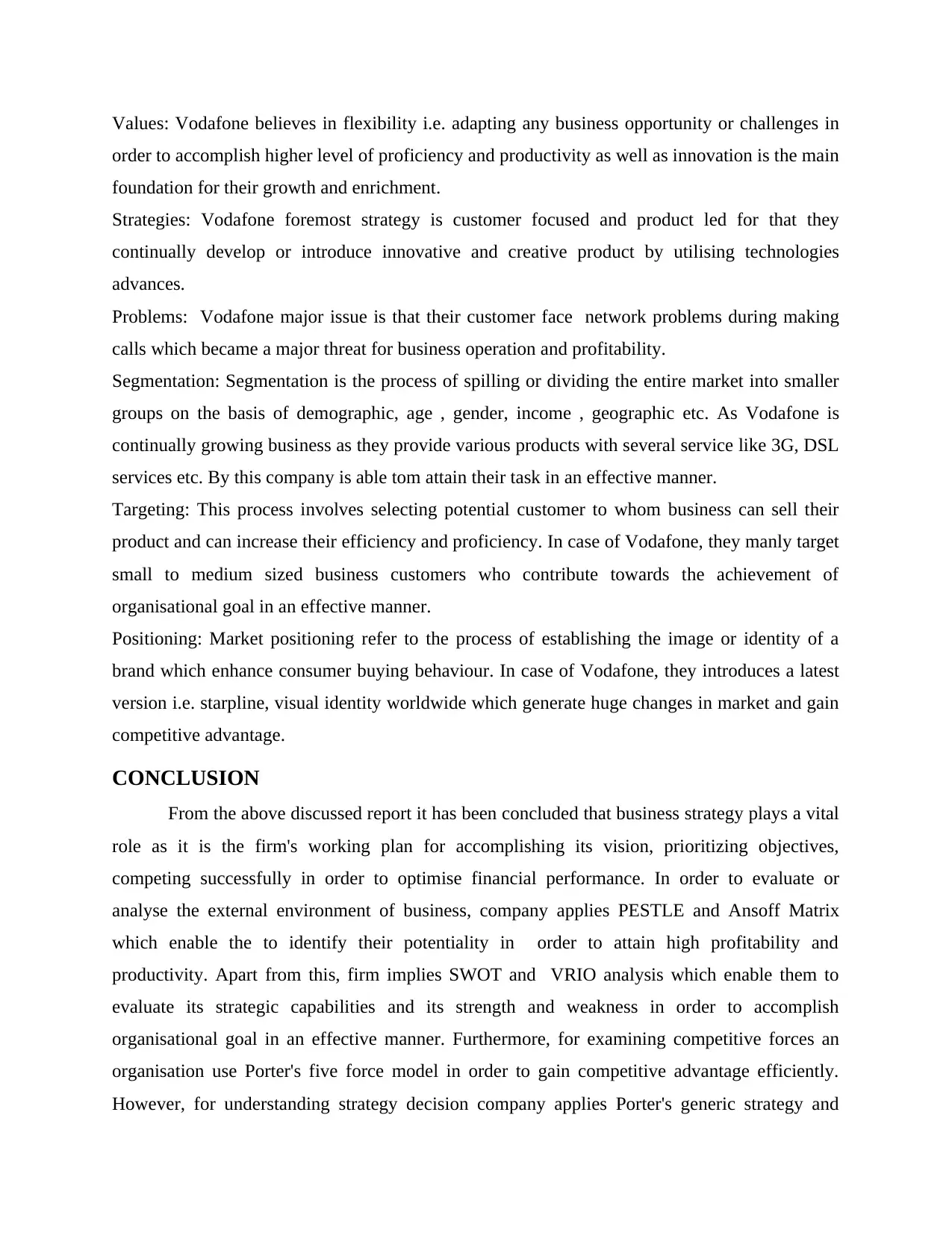
Values: Vodafone believes in flexibility i.e. adapting any business opportunity or challenges in
order to accomplish higher level of proficiency and productivity as well as innovation is the main
foundation for their growth and enrichment.
Strategies: Vodafone foremost strategy is customer focused and product led for that they
continually develop or introduce innovative and creative product by utilising technologies
advances.
Problems: Vodafone major issue is that their customer face network problems during making
calls which became a major threat for business operation and profitability.
Segmentation: Segmentation is the process of spilling or dividing the entire market into smaller
groups on the basis of demographic, age , gender, income , geographic etc. As Vodafone is
continually growing business as they provide various products with several service like 3G, DSL
services etc. By this company is able tom attain their task in an effective manner.
Targeting: This process involves selecting potential customer to whom business can sell their
product and can increase their efficiency and proficiency. In case of Vodafone, they manly target
small to medium sized business customers who contribute towards the achievement of
organisational goal in an effective manner.
Positioning: Market positioning refer to the process of establishing the image or identity of a
brand which enhance consumer buying behaviour. In case of Vodafone, they introduces a latest
version i.e. starpline, visual identity worldwide which generate huge changes in market and gain
competitive advantage.
CONCLUSION
From the above discussed report it has been concluded that business strategy plays a vital
role as it is the firm's working plan for accomplishing its vision, prioritizing objectives,
competing successfully in order to optimise financial performance. In order to evaluate or
analyse the external environment of business, company applies PESTLE and Ansoff Matrix
which enable the to identify their potentiality in order to attain high profitability and
productivity. Apart from this, firm implies SWOT and VRIO analysis which enable them to
evaluate its strategic capabilities and its strength and weakness in order to accomplish
organisational goal in an effective manner. Furthermore, for examining competitive forces an
organisation use Porter's five force model in order to gain competitive advantage efficiently.
However, for understanding strategy decision company applies Porter's generic strategy and
order to accomplish higher level of proficiency and productivity as well as innovation is the main
foundation for their growth and enrichment.
Strategies: Vodafone foremost strategy is customer focused and product led for that they
continually develop or introduce innovative and creative product by utilising technologies
advances.
Problems: Vodafone major issue is that their customer face network problems during making
calls which became a major threat for business operation and profitability.
Segmentation: Segmentation is the process of spilling or dividing the entire market into smaller
groups on the basis of demographic, age , gender, income , geographic etc. As Vodafone is
continually growing business as they provide various products with several service like 3G, DSL
services etc. By this company is able tom attain their task in an effective manner.
Targeting: This process involves selecting potential customer to whom business can sell their
product and can increase their efficiency and proficiency. In case of Vodafone, they manly target
small to medium sized business customers who contribute towards the achievement of
organisational goal in an effective manner.
Positioning: Market positioning refer to the process of establishing the image or identity of a
brand which enhance consumer buying behaviour. In case of Vodafone, they introduces a latest
version i.e. starpline, visual identity worldwide which generate huge changes in market and gain
competitive advantage.
CONCLUSION
From the above discussed report it has been concluded that business strategy plays a vital
role as it is the firm's working plan for accomplishing its vision, prioritizing objectives,
competing successfully in order to optimise financial performance. In order to evaluate or
analyse the external environment of business, company applies PESTLE and Ansoff Matrix
which enable the to identify their potentiality in order to attain high profitability and
productivity. Apart from this, firm implies SWOT and VRIO analysis which enable them to
evaluate its strategic capabilities and its strength and weakness in order to accomplish
organisational goal in an effective manner. Furthermore, for examining competitive forces an
organisation use Porter's five force model in order to gain competitive advantage efficiently.
However, for understanding strategy decision company applies Porter's generic strategy and

Bowman's strategy in order to attain higher level of efficiency as well they develop an effective
strategic plan which enrich their business growth and improve overall performance of company.
strategic plan which enrich their business growth and improve overall performance of company.
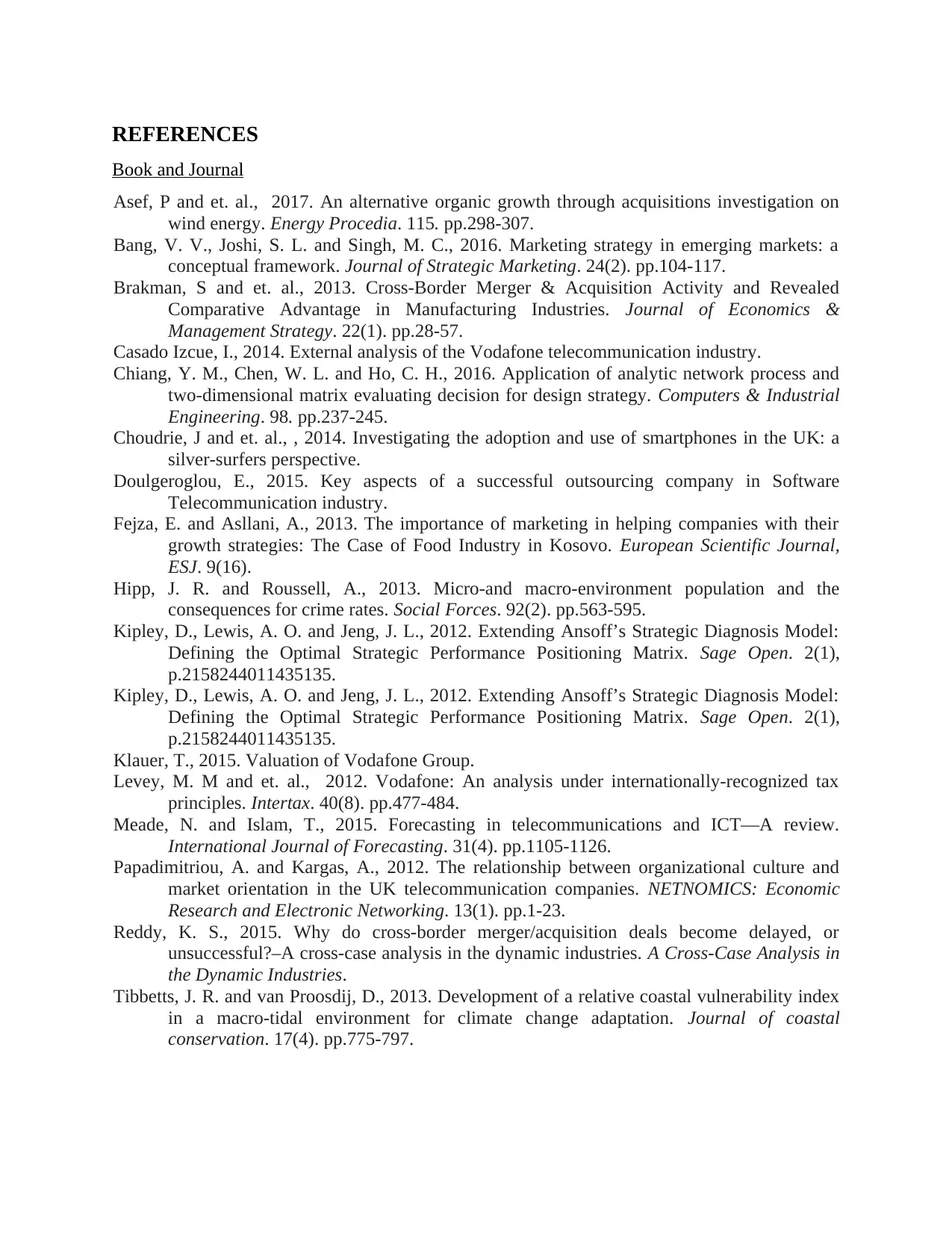
REFERENCES
Book and Journal
Asef, P and et. al., 2017. An alternative organic growth through acquisitions investigation on
wind energy. Energy Procedia. 115. pp.298-307.
Bang, V. V., Joshi, S. L. and Singh, M. C., 2016. Marketing strategy in emerging markets: a
conceptual framework. Journal of Strategic Marketing. 24(2). pp.104-117.
Brakman, S and et. al., 2013. Cross‐Border Merger & Acquisition Activity and Revealed
Comparative Advantage in Manufacturing Industries. Journal of Economics &
Management Strategy. 22(1). pp.28-57.
Casado Izcue, I., 2014. External analysis of the Vodafone telecommunication industry.
Chiang, Y. M., Chen, W. L. and Ho, C. H., 2016. Application of analytic network process and
two-dimensional matrix evaluating decision for design strategy. Computers & Industrial
Engineering. 98. pp.237-245.
Choudrie, J and et. al., , 2014. Investigating the adoption and use of smartphones in the UK: a
silver-surfers perspective.
Doulgeroglou, E., 2015. Key aspects of a successful outsourcing company in Software
Telecommunication industry.
Fejza, E. and Asllani, A., 2013. The importance of marketing in helping companies with their
growth strategies: The Case of Food Industry in Kosovo. European Scientific Journal,
ESJ. 9(16).
Hipp, J. R. and Roussell, A., 2013. Micro-and macro-environment population and the
consequences for crime rates. Social Forces. 92(2). pp.563-595.
Kipley, D., Lewis, A. O. and Jeng, J. L., 2012. Extending Ansoff’s Strategic Diagnosis Model:
Defining the Optimal Strategic Performance Positioning Matrix. Sage Open. 2(1),
p.2158244011435135.
Kipley, D., Lewis, A. O. and Jeng, J. L., 2012. Extending Ansoff’s Strategic Diagnosis Model:
Defining the Optimal Strategic Performance Positioning Matrix. Sage Open. 2(1),
p.2158244011435135.
Klauer, T., 2015. Valuation of Vodafone Group.
Levey, M. M and et. al., 2012. Vodafone: An analysis under internationally-recognized tax
principles. Intertax. 40(8). pp.477-484.
Meade, N. and Islam, T., 2015. Forecasting in telecommunications and ICT—A review.
International Journal of Forecasting. 31(4). pp.1105-1126.
Papadimitriou, A. and Kargas, A., 2012. The relationship between organizational culture and
market orientation in the UK telecommunication companies. NETNOMICS: Economic
Research and Electronic Networking. 13(1). pp.1-23.
Reddy, K. S., 2015. Why do cross-border merger/acquisition deals become delayed, or
unsuccessful?–A cross-case analysis in the dynamic industries. A Cross-Case Analysis in
the Dynamic Industries.
Tibbetts, J. R. and van Proosdij, D., 2013. Development of a relative coastal vulnerability index
in a macro-tidal environment for climate change adaptation. Journal of coastal
conservation. 17(4). pp.775-797.
Book and Journal
Asef, P and et. al., 2017. An alternative organic growth through acquisitions investigation on
wind energy. Energy Procedia. 115. pp.298-307.
Bang, V. V., Joshi, S. L. and Singh, M. C., 2016. Marketing strategy in emerging markets: a
conceptual framework. Journal of Strategic Marketing. 24(2). pp.104-117.
Brakman, S and et. al., 2013. Cross‐Border Merger & Acquisition Activity and Revealed
Comparative Advantage in Manufacturing Industries. Journal of Economics &
Management Strategy. 22(1). pp.28-57.
Casado Izcue, I., 2014. External analysis of the Vodafone telecommunication industry.
Chiang, Y. M., Chen, W. L. and Ho, C. H., 2016. Application of analytic network process and
two-dimensional matrix evaluating decision for design strategy. Computers & Industrial
Engineering. 98. pp.237-245.
Choudrie, J and et. al., , 2014. Investigating the adoption and use of smartphones in the UK: a
silver-surfers perspective.
Doulgeroglou, E., 2015. Key aspects of a successful outsourcing company in Software
Telecommunication industry.
Fejza, E. and Asllani, A., 2013. The importance of marketing in helping companies with their
growth strategies: The Case of Food Industry in Kosovo. European Scientific Journal,
ESJ. 9(16).
Hipp, J. R. and Roussell, A., 2013. Micro-and macro-environment population and the
consequences for crime rates. Social Forces. 92(2). pp.563-595.
Kipley, D., Lewis, A. O. and Jeng, J. L., 2012. Extending Ansoff’s Strategic Diagnosis Model:
Defining the Optimal Strategic Performance Positioning Matrix. Sage Open. 2(1),
p.2158244011435135.
Kipley, D., Lewis, A. O. and Jeng, J. L., 2012. Extending Ansoff’s Strategic Diagnosis Model:
Defining the Optimal Strategic Performance Positioning Matrix. Sage Open. 2(1),
p.2158244011435135.
Klauer, T., 2015. Valuation of Vodafone Group.
Levey, M. M and et. al., 2012. Vodafone: An analysis under internationally-recognized tax
principles. Intertax. 40(8). pp.477-484.
Meade, N. and Islam, T., 2015. Forecasting in telecommunications and ICT—A review.
International Journal of Forecasting. 31(4). pp.1105-1126.
Papadimitriou, A. and Kargas, A., 2012. The relationship between organizational culture and
market orientation in the UK telecommunication companies. NETNOMICS: Economic
Research and Electronic Networking. 13(1). pp.1-23.
Reddy, K. S., 2015. Why do cross-border merger/acquisition deals become delayed, or
unsuccessful?–A cross-case analysis in the dynamic industries. A Cross-Case Analysis in
the Dynamic Industries.
Tibbetts, J. R. and van Proosdij, D., 2013. Development of a relative coastal vulnerability index
in a macro-tidal environment for climate change adaptation. Journal of coastal
conservation. 17(4). pp.775-797.
Paraphrase This Document
Need a fresh take? Get an instant paraphrase of this document with our AI Paraphraser

Online
Vodafone Group Plc , Porter's Five Forces, 2019 [Online]. Available through;
<https://writepass.com/journal/2012/09/vodafone-group-plc-swot-analysis-and-porters-five-
forces/>
Vodafone Group Plc , Porter's Five Forces, 2019 [Online]. Available through;
<https://writepass.com/journal/2012/09/vodafone-group-plc-swot-analysis-and-porters-five-
forces/>
1 out of 20
Related Documents
Your All-in-One AI-Powered Toolkit for Academic Success.
+13062052269
info@desklib.com
Available 24*7 on WhatsApp / Email
![[object Object]](/_next/static/media/star-bottom.7253800d.svg)
Unlock your academic potential
© 2024 | Zucol Services PVT LTD | All rights reserved.





